Drama III/5. British drama came of age

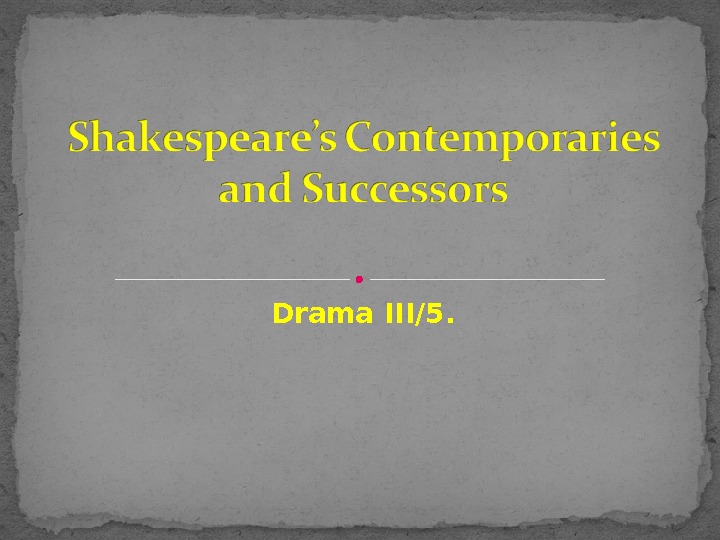
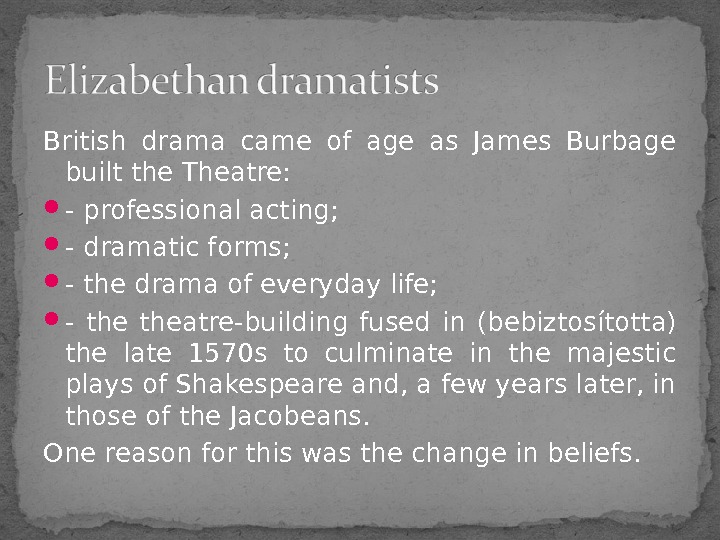
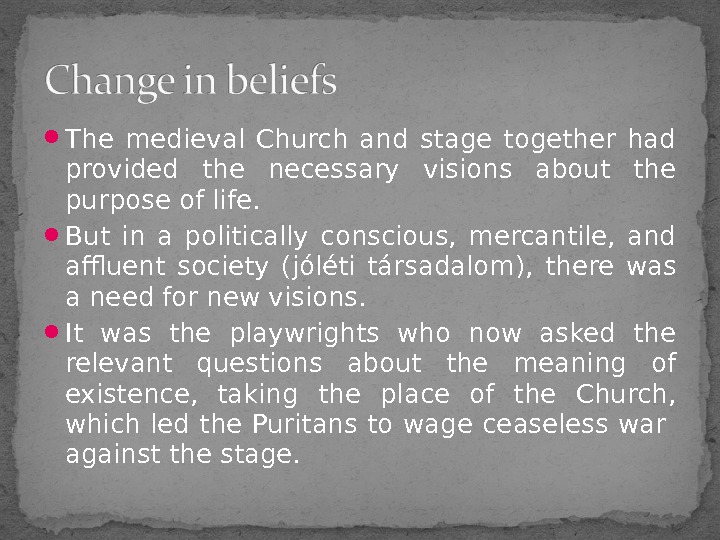
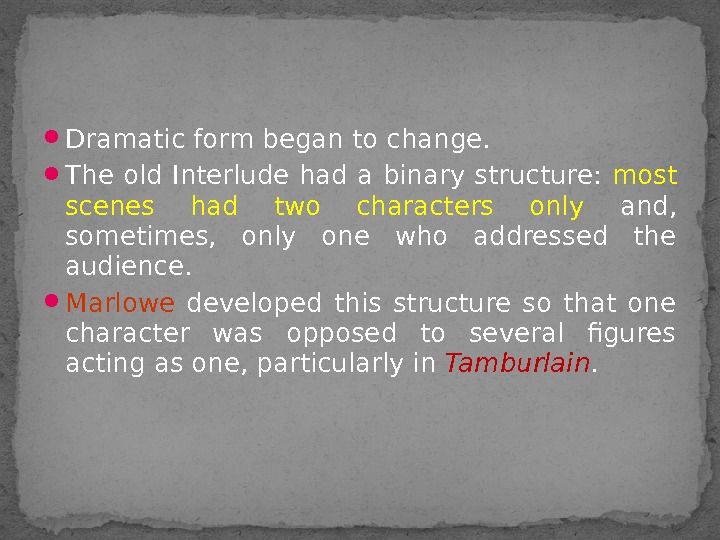

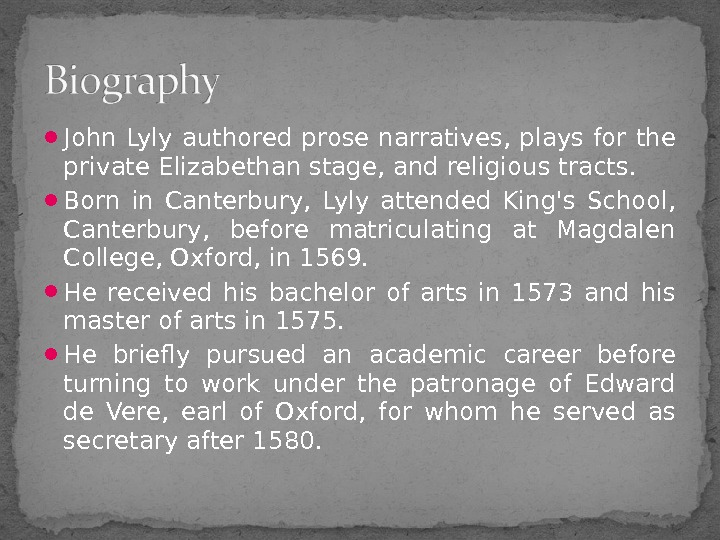
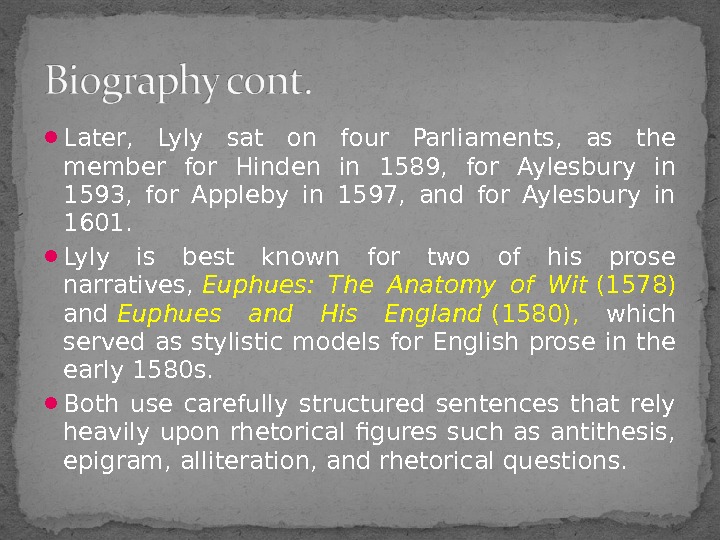
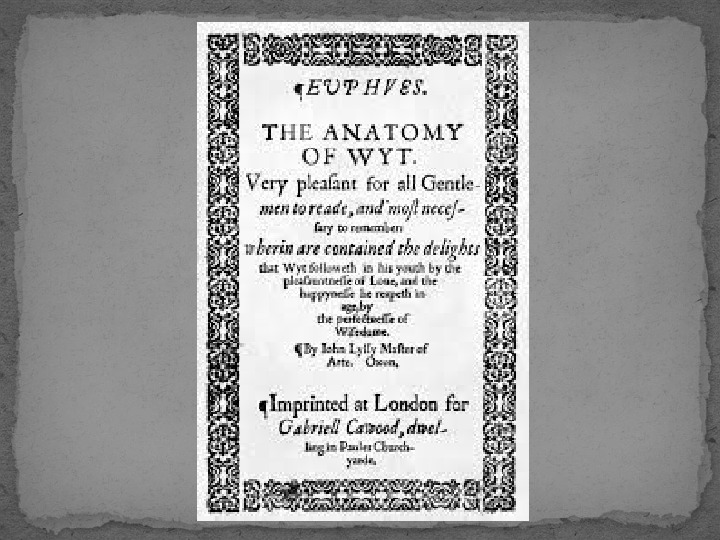
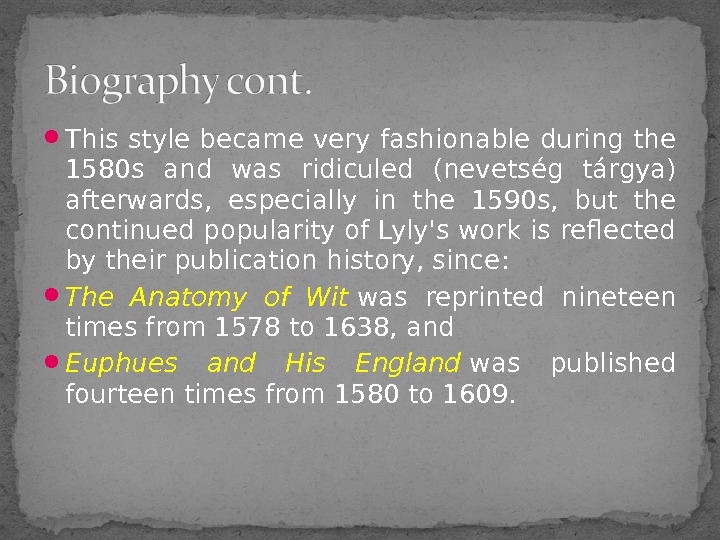
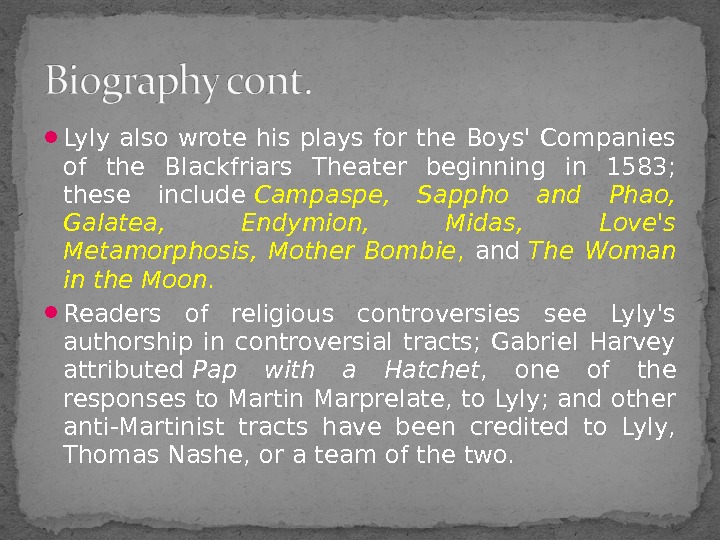

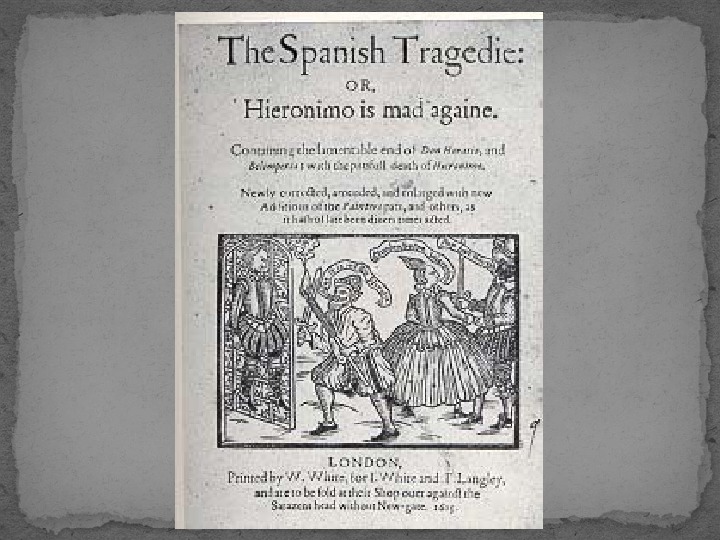

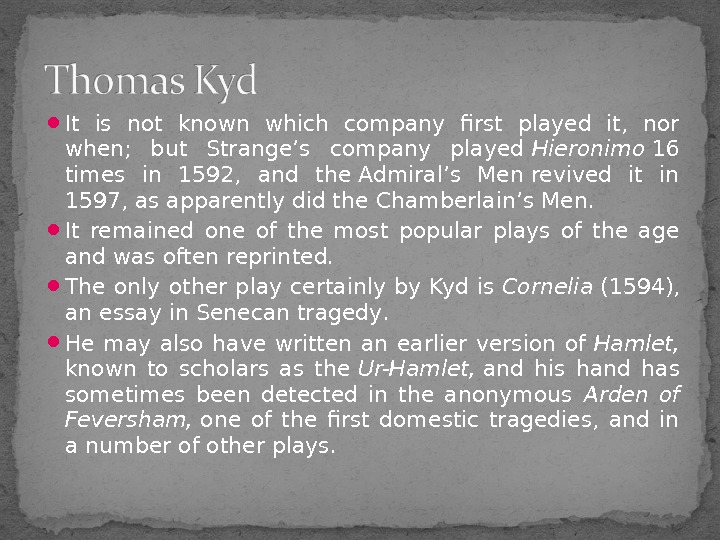
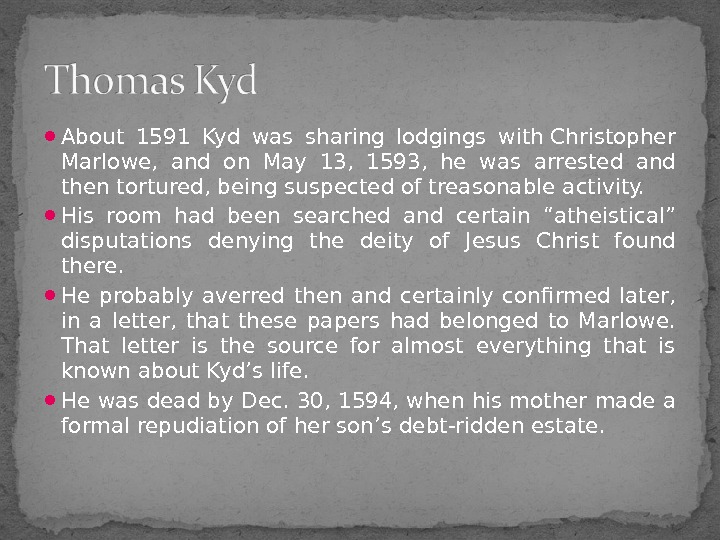
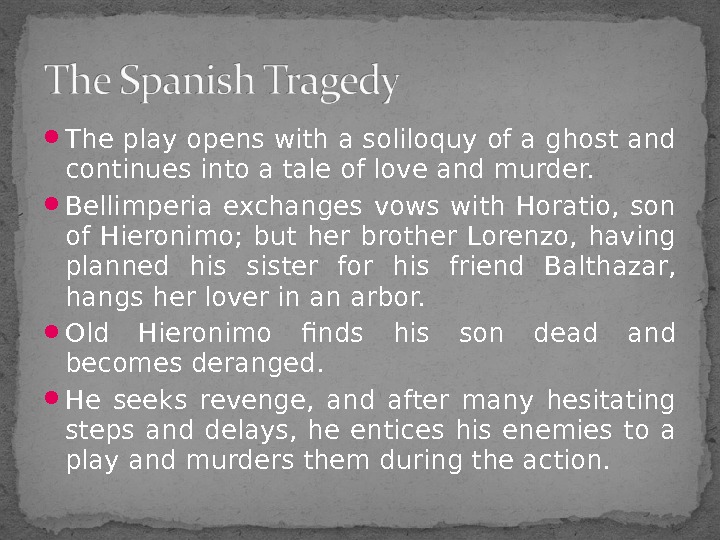
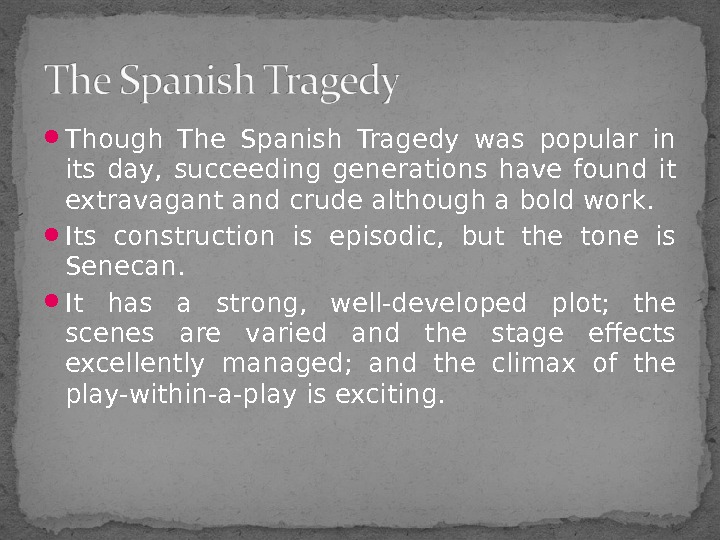
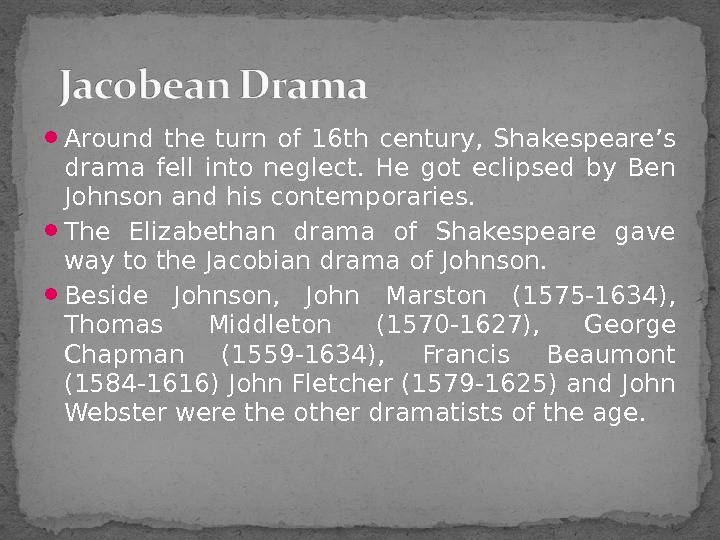
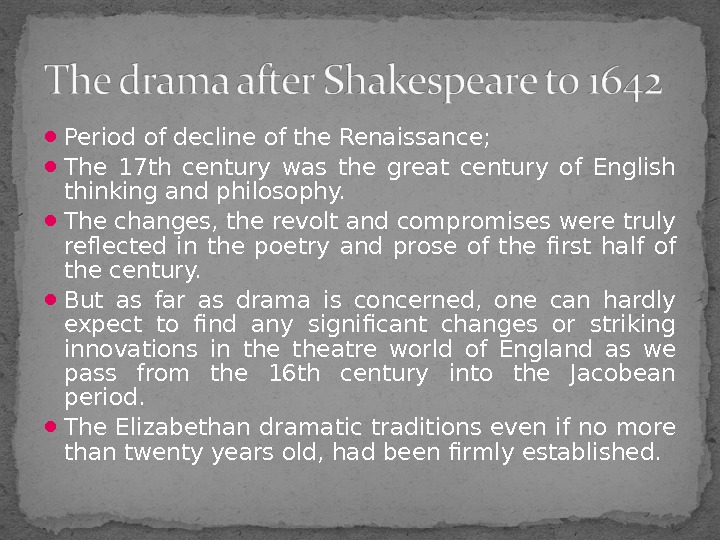
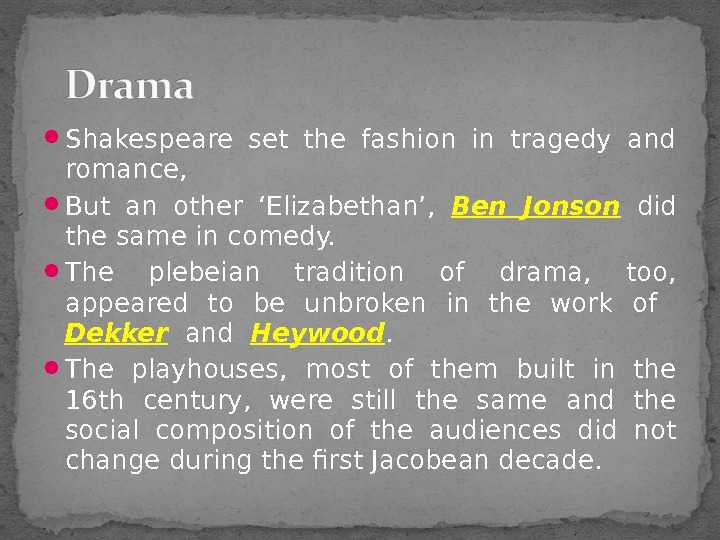
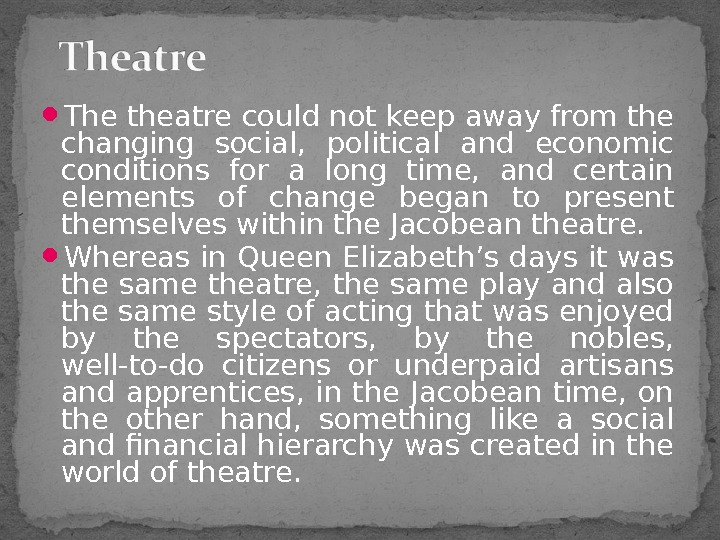

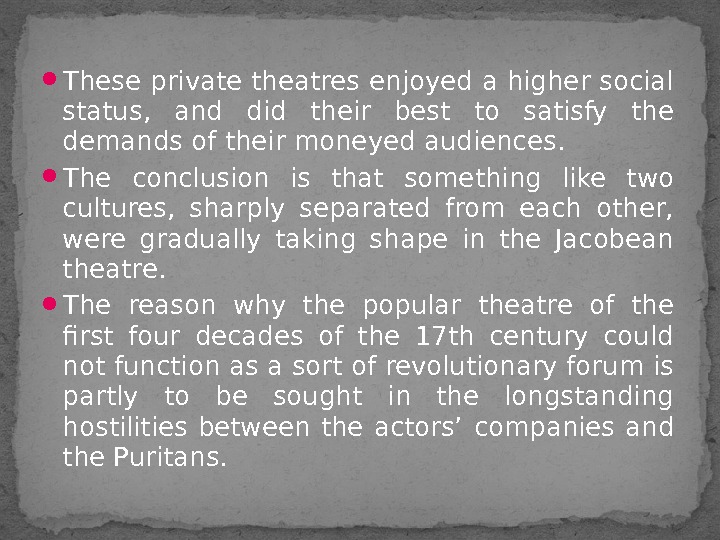
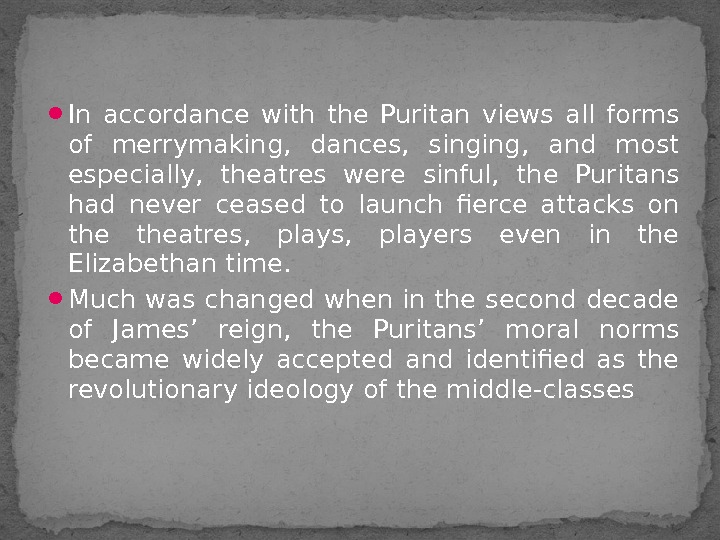
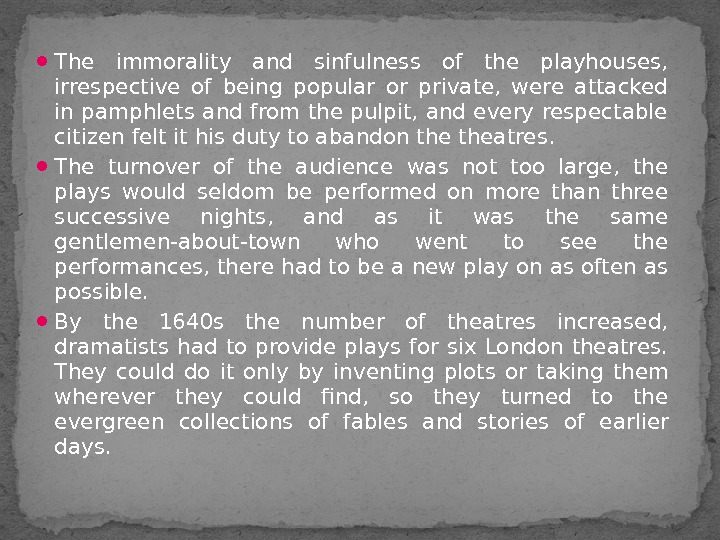
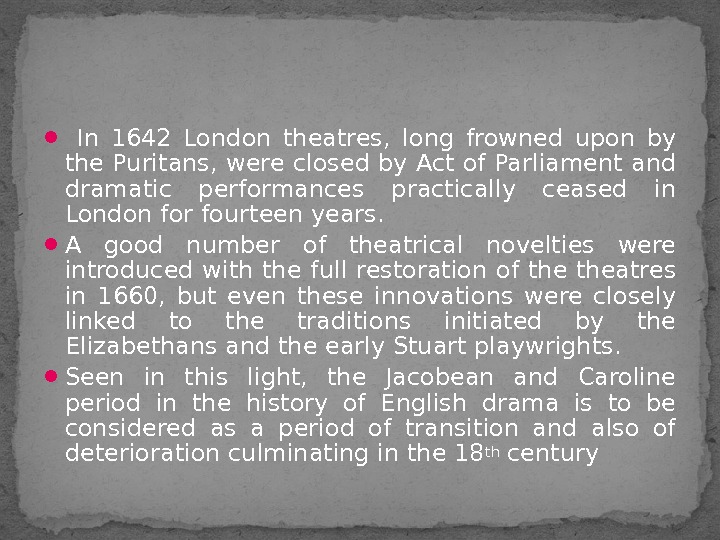

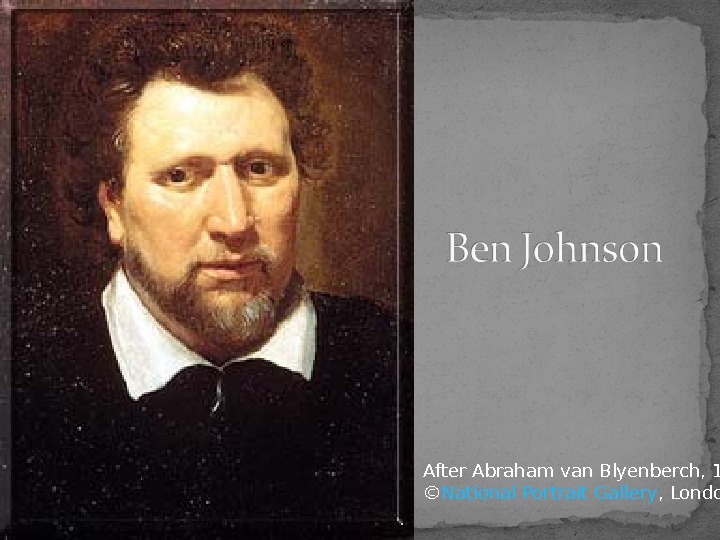
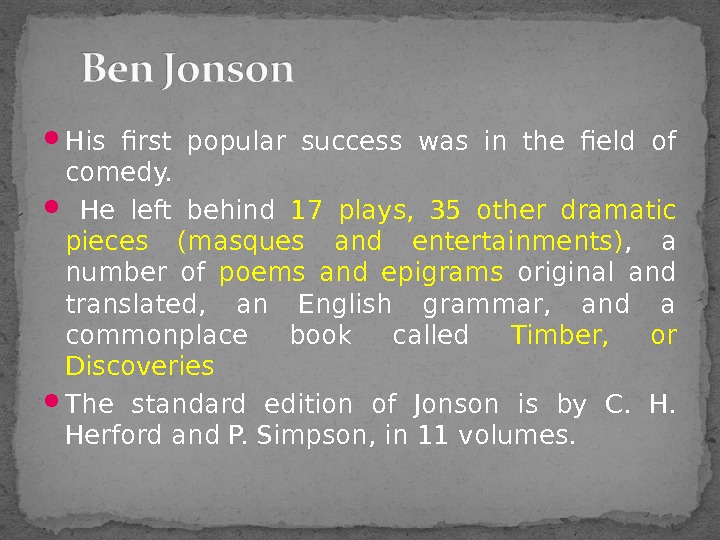
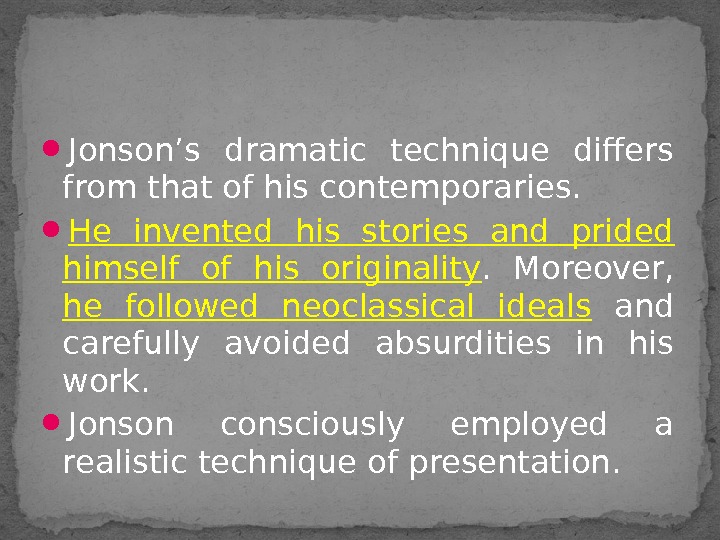
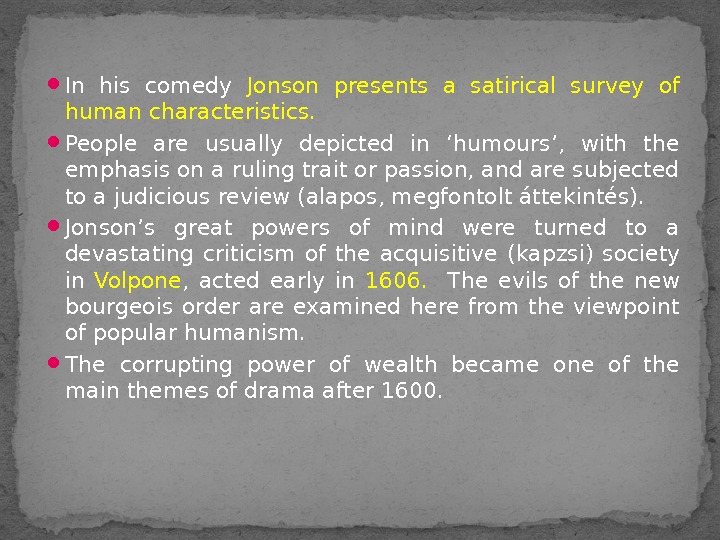
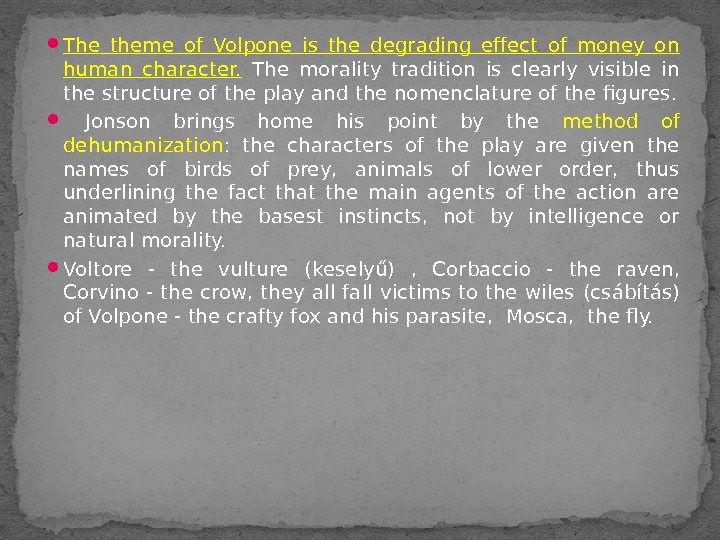
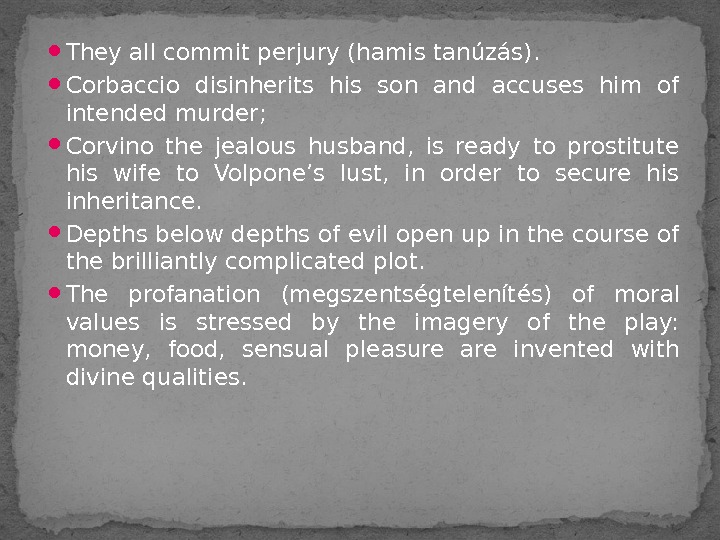
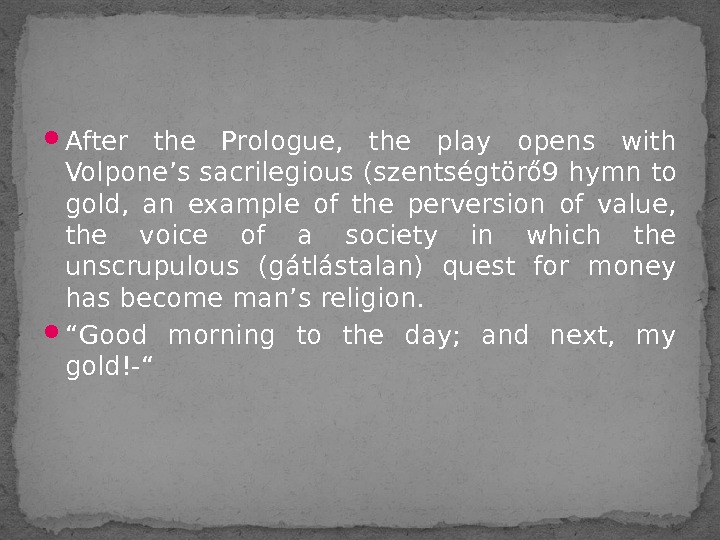

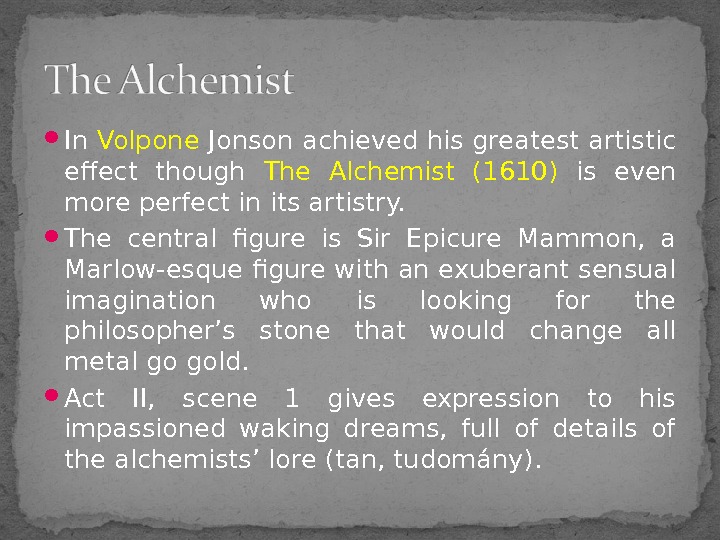
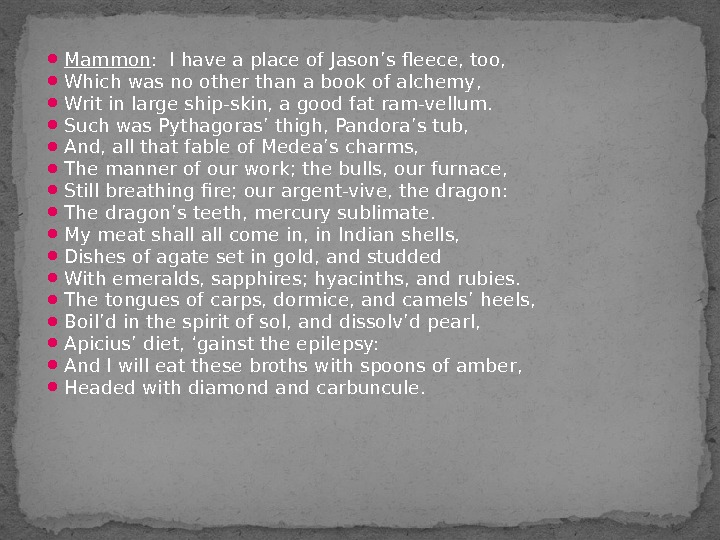
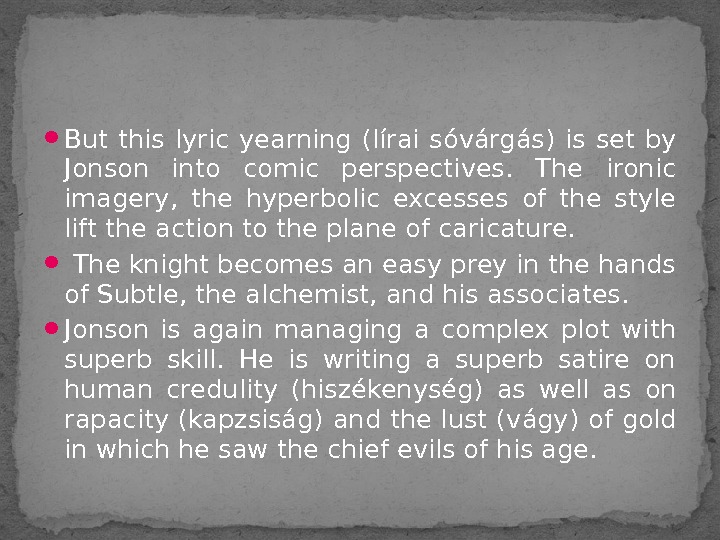
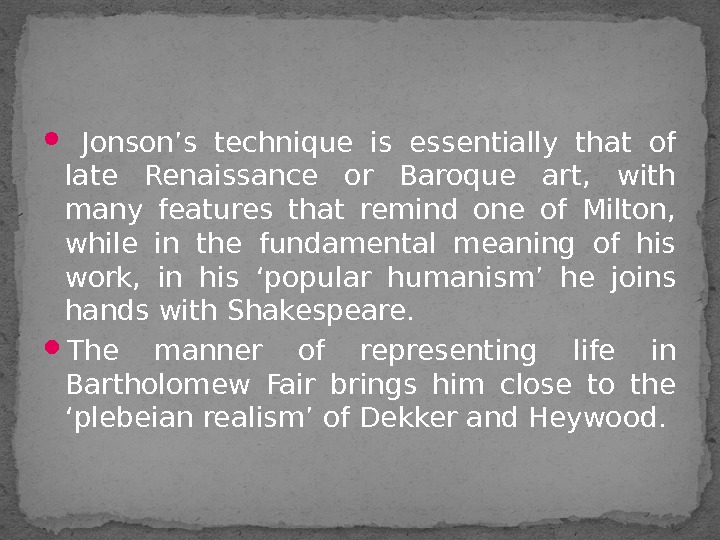
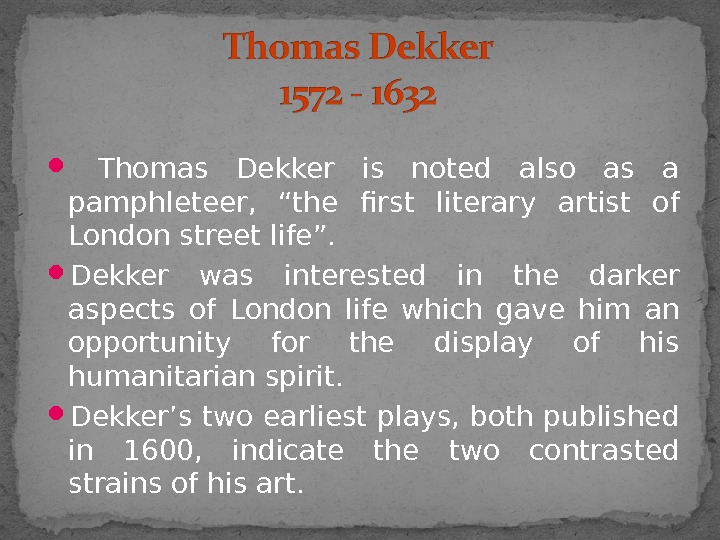
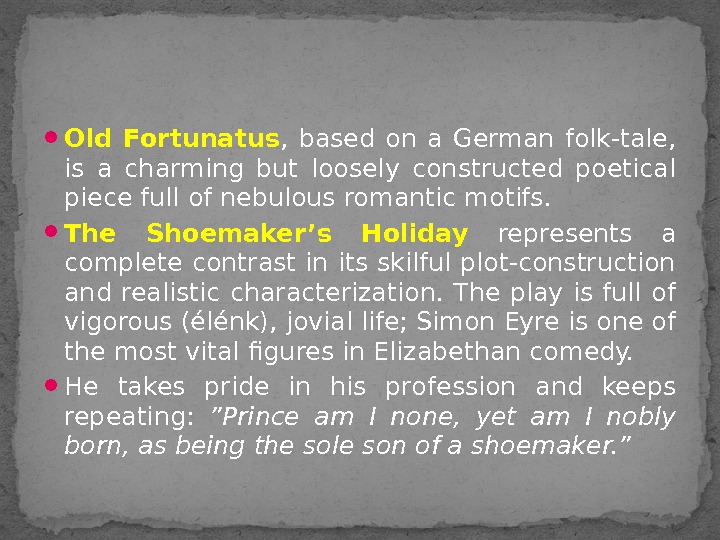
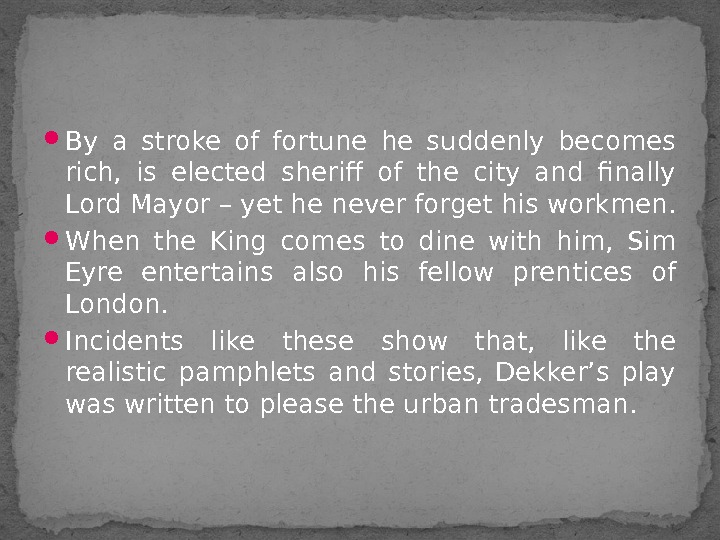
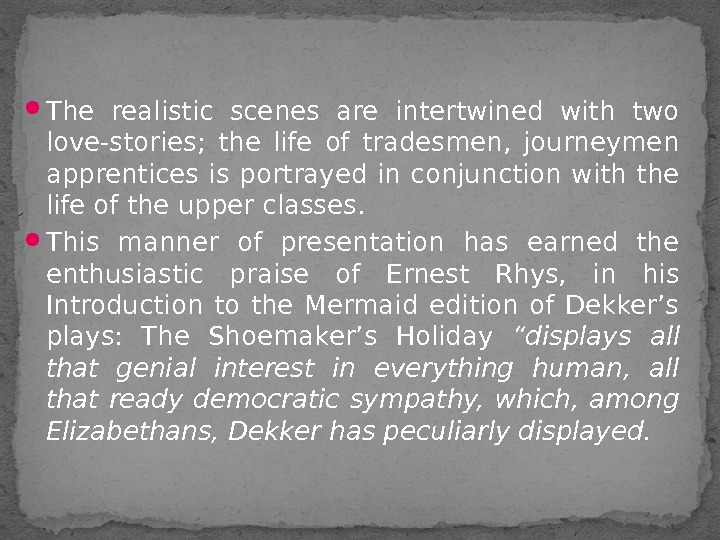
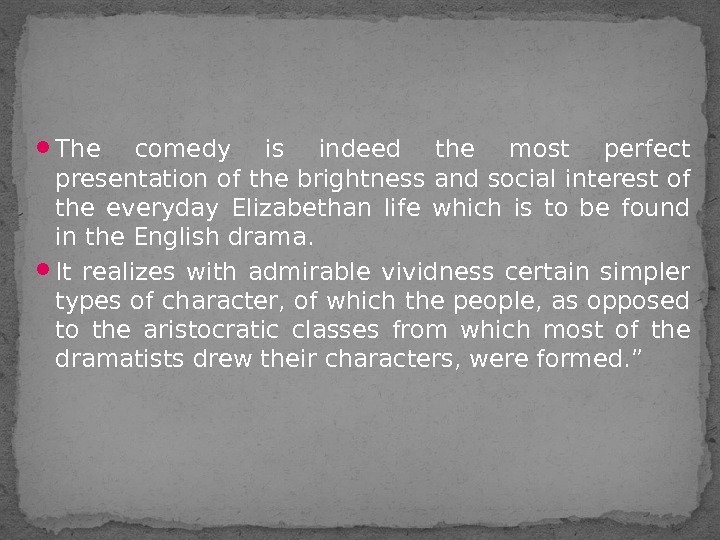
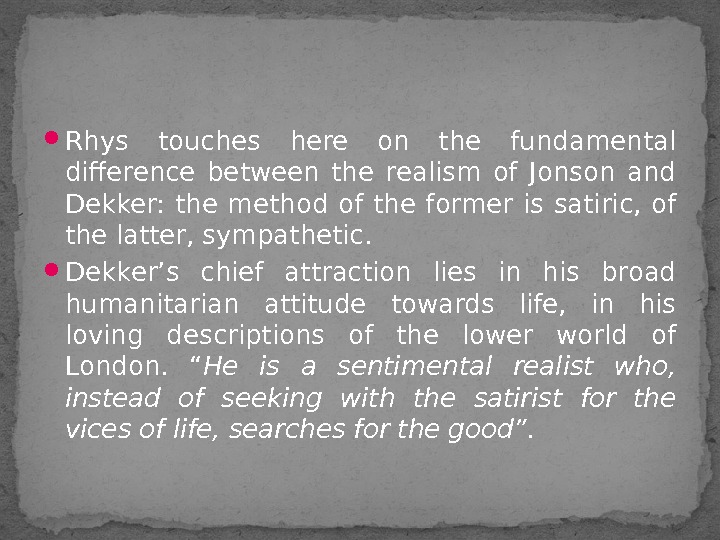
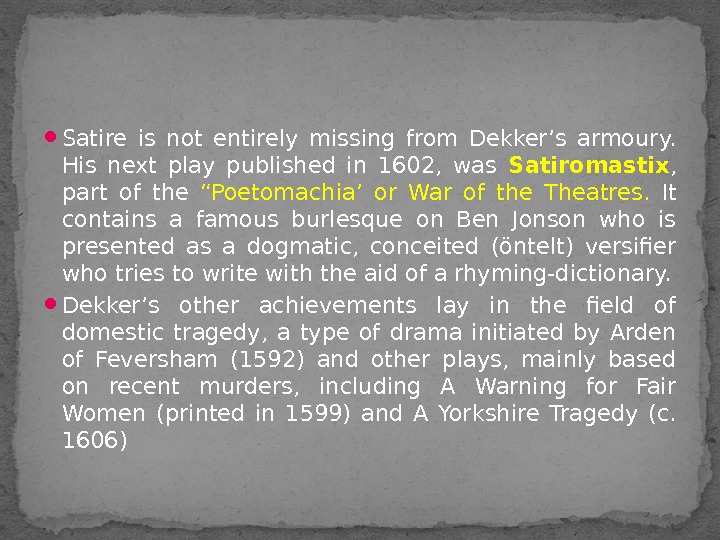
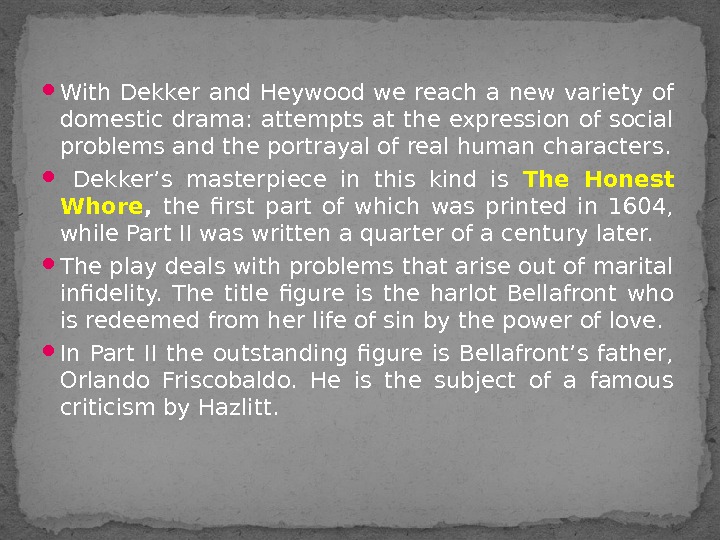
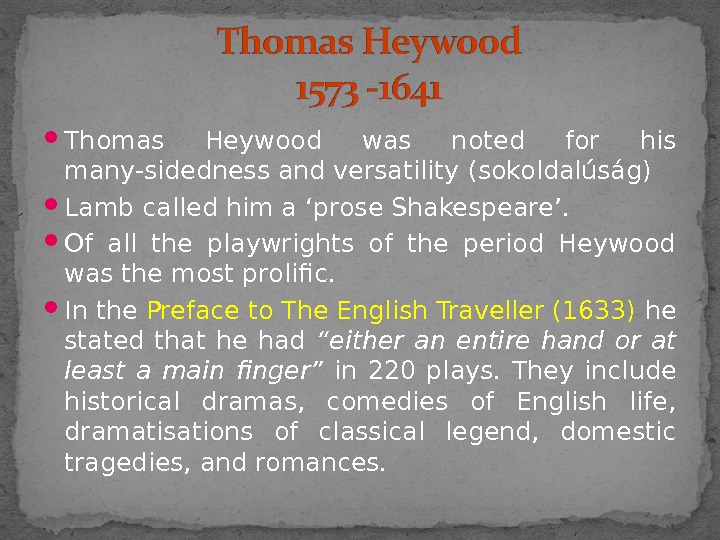
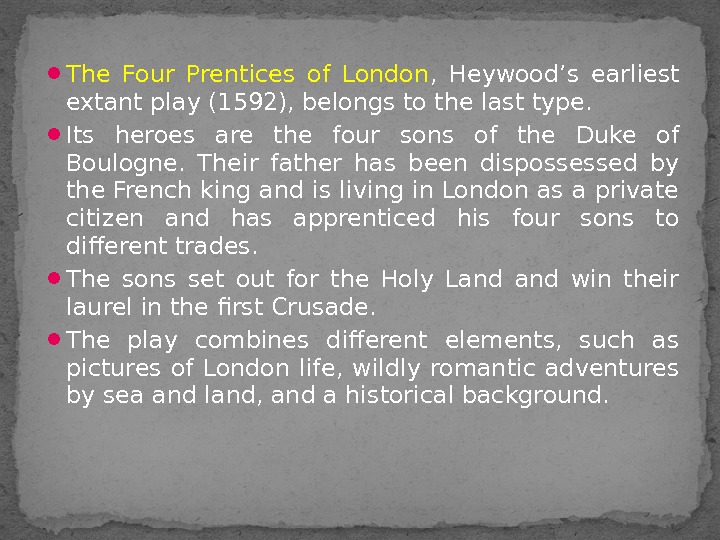
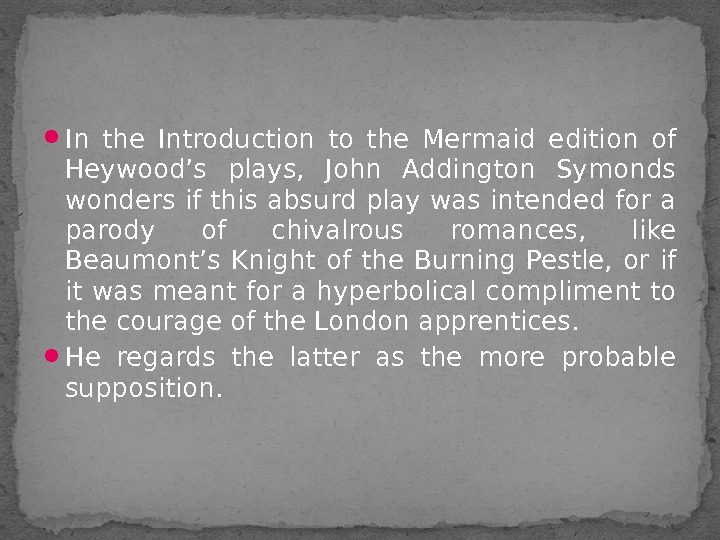
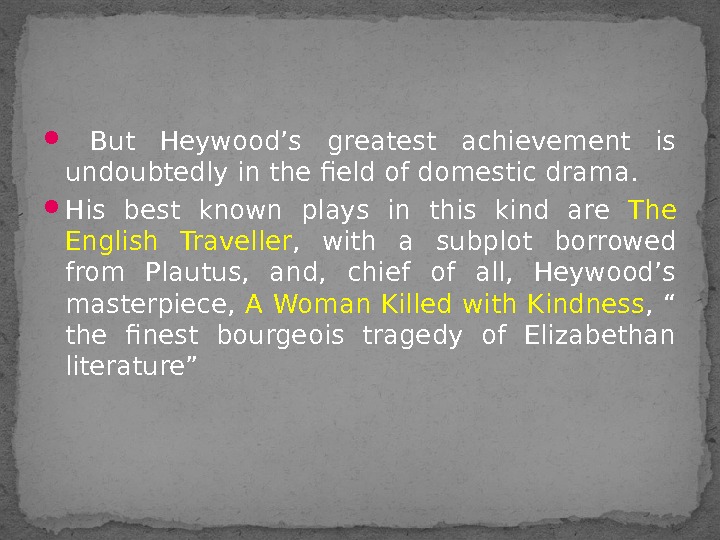

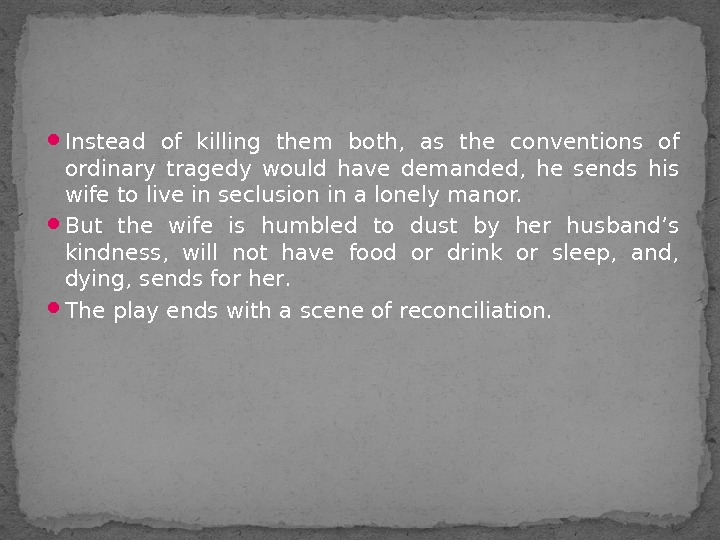
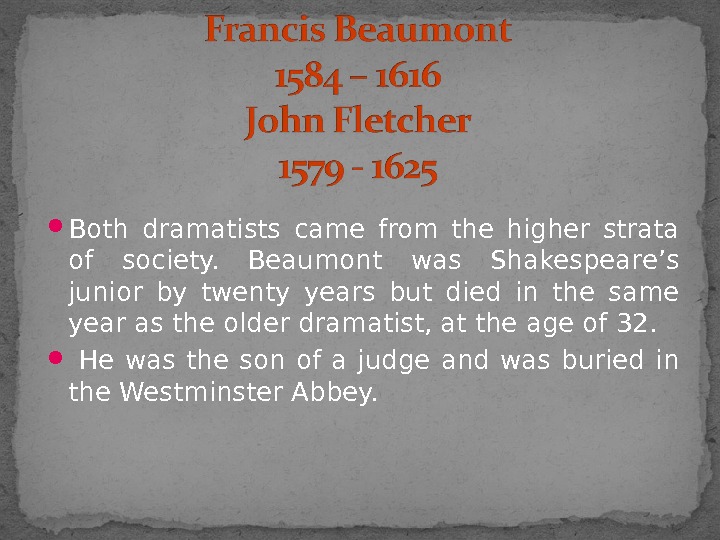
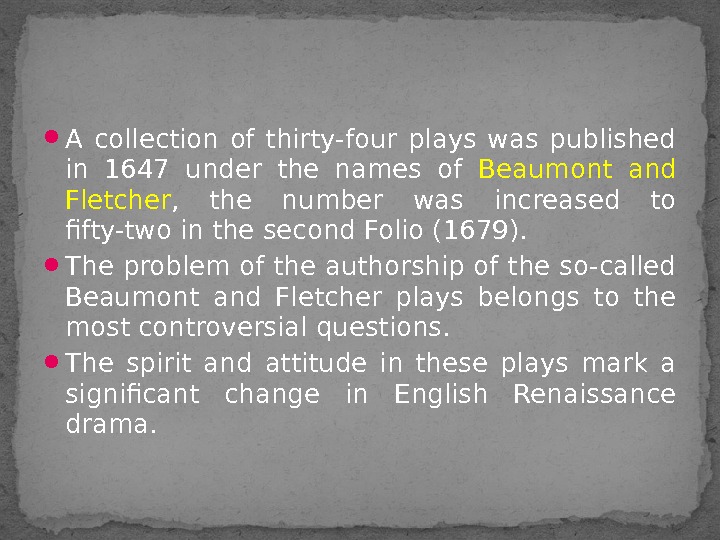
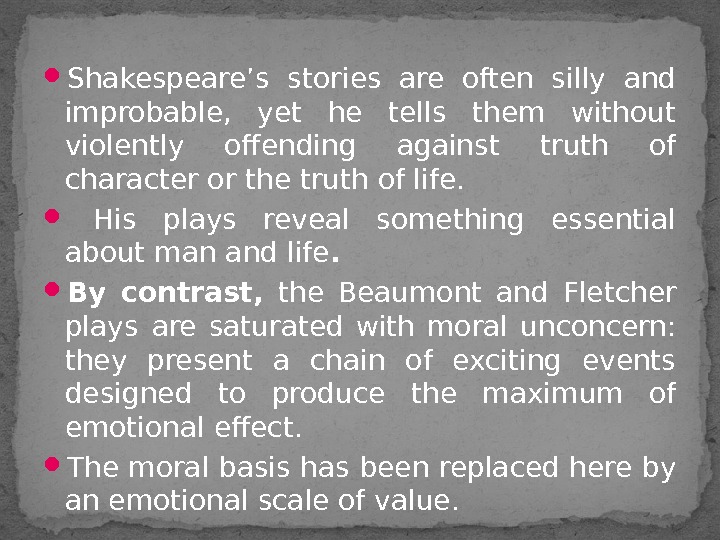
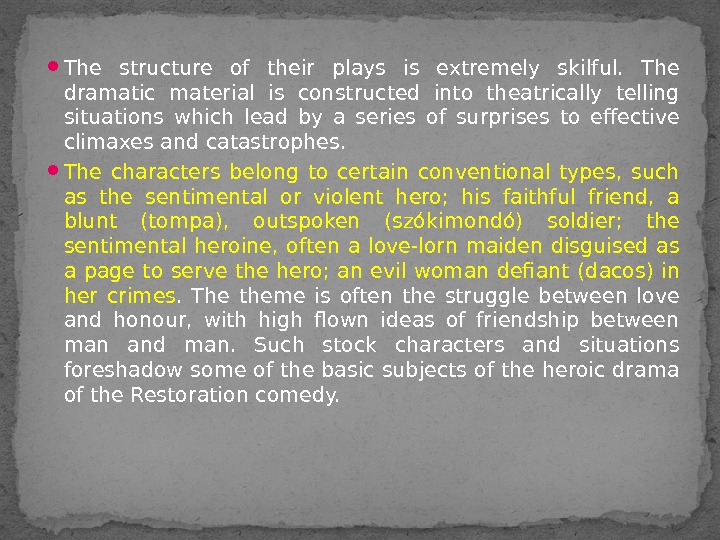
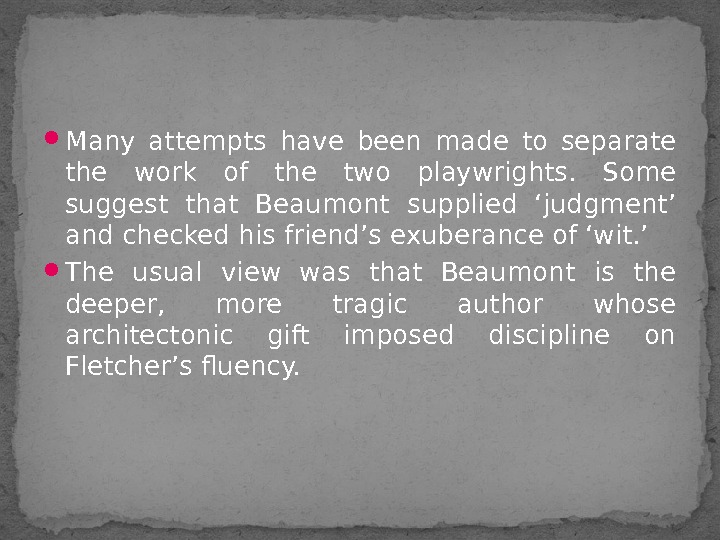
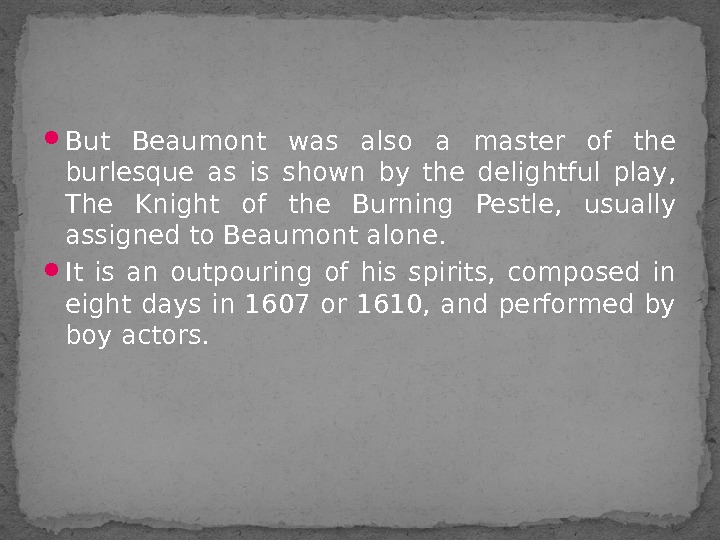
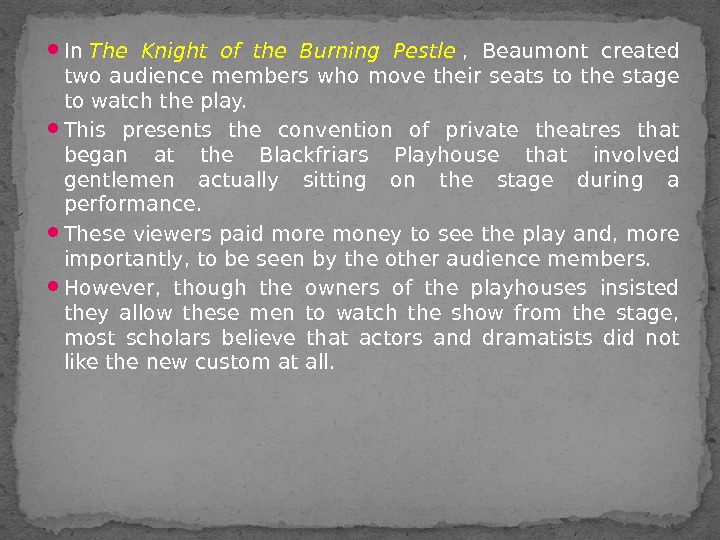
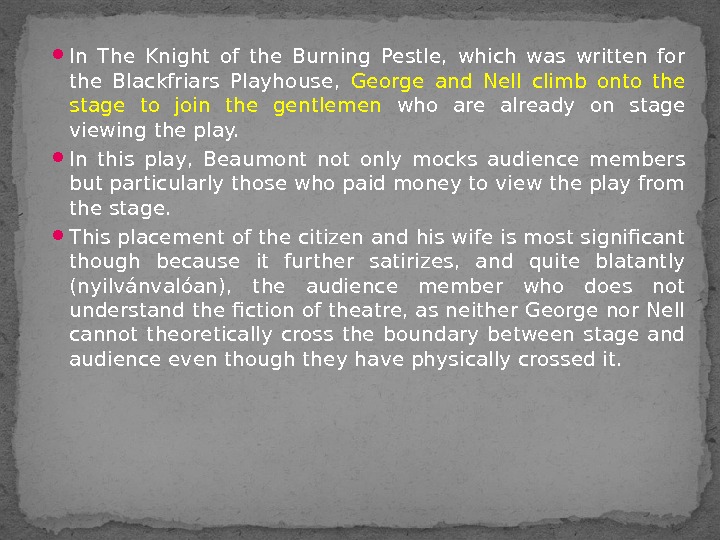

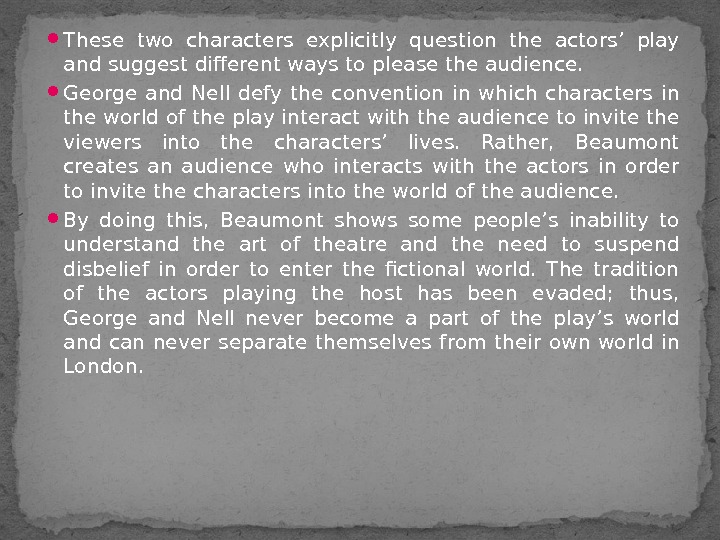
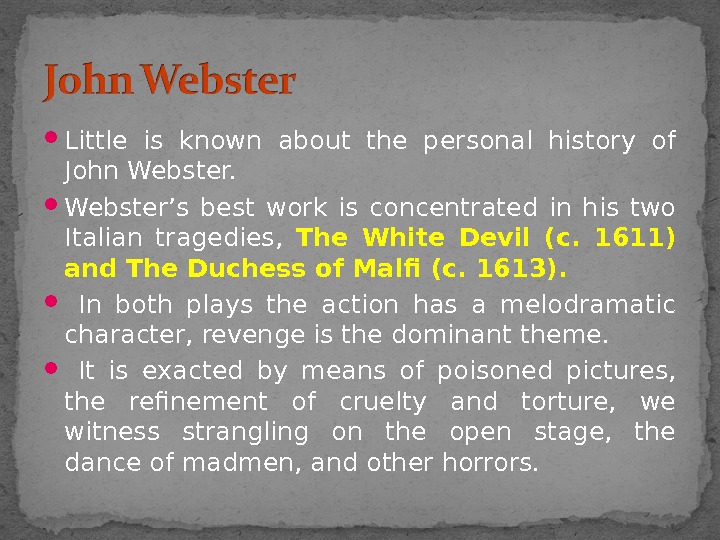
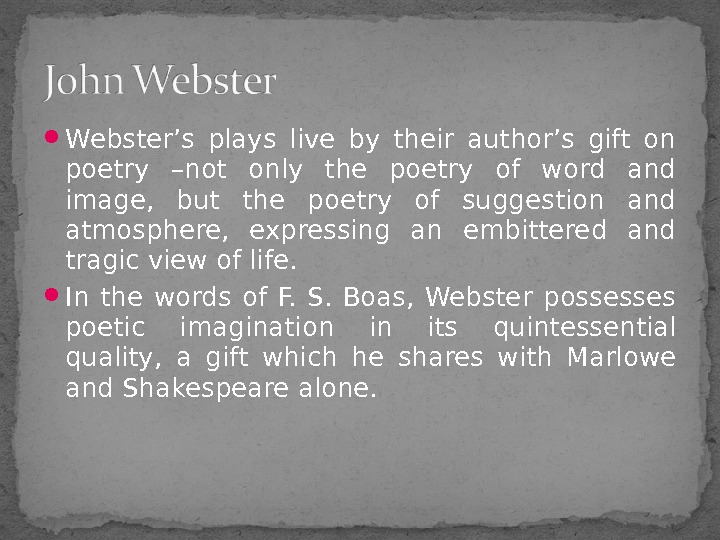
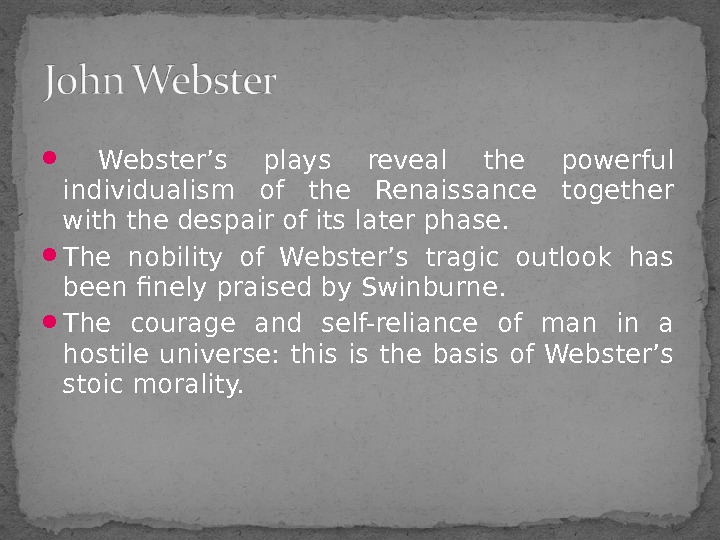
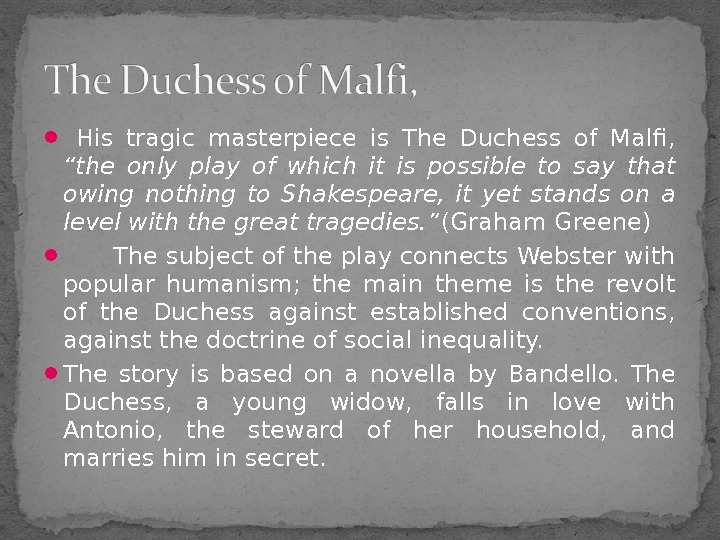
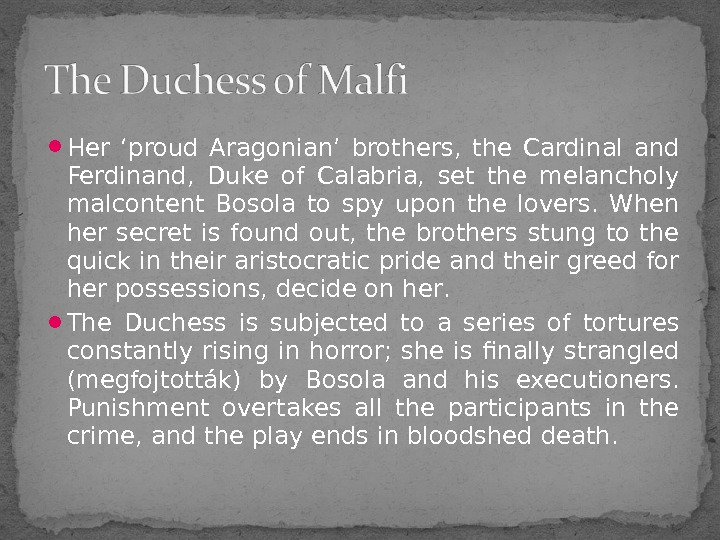
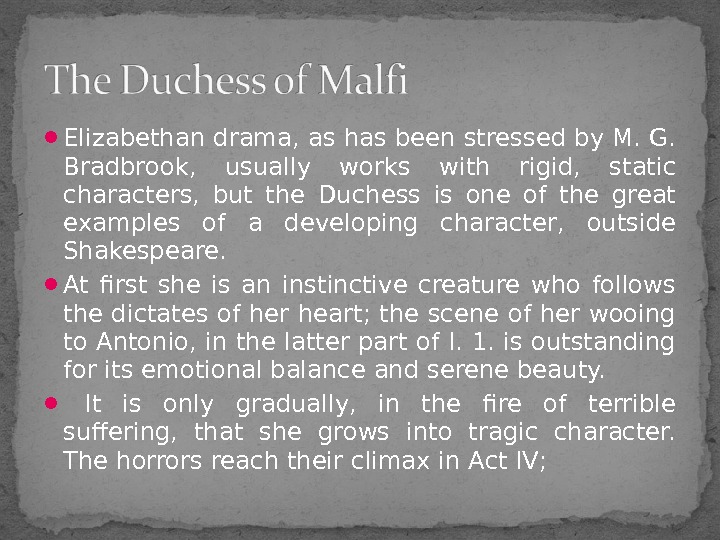
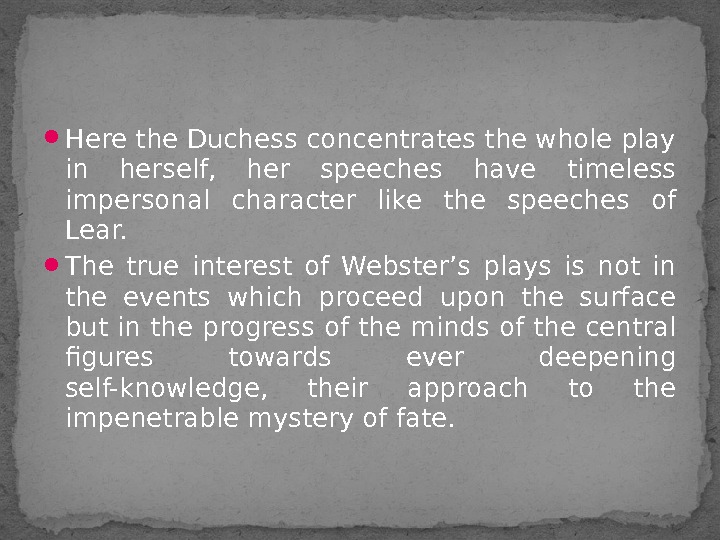

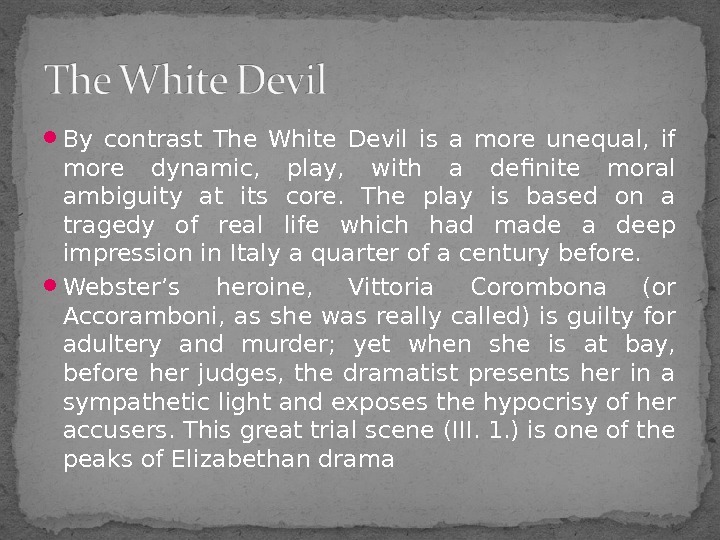
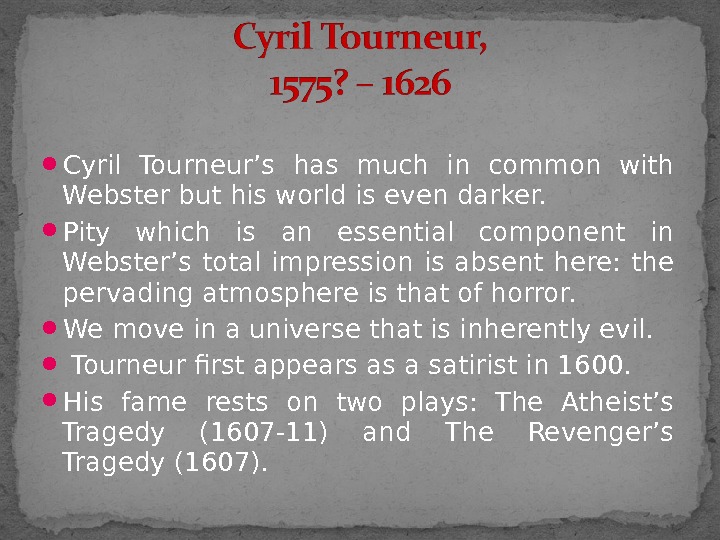
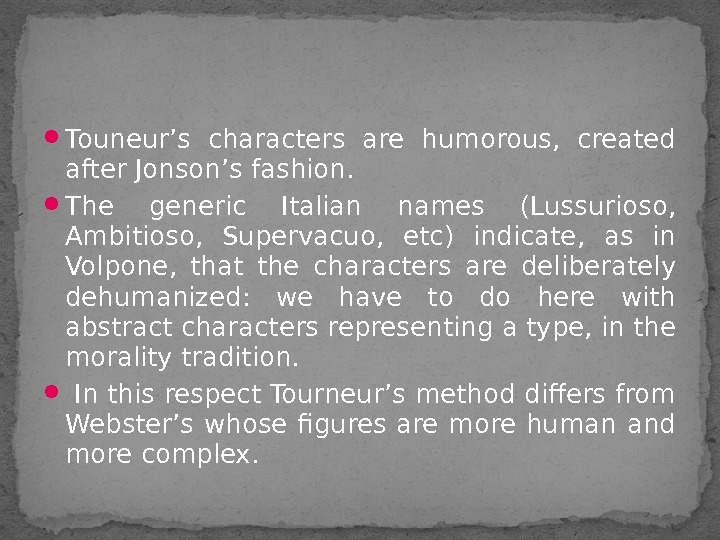
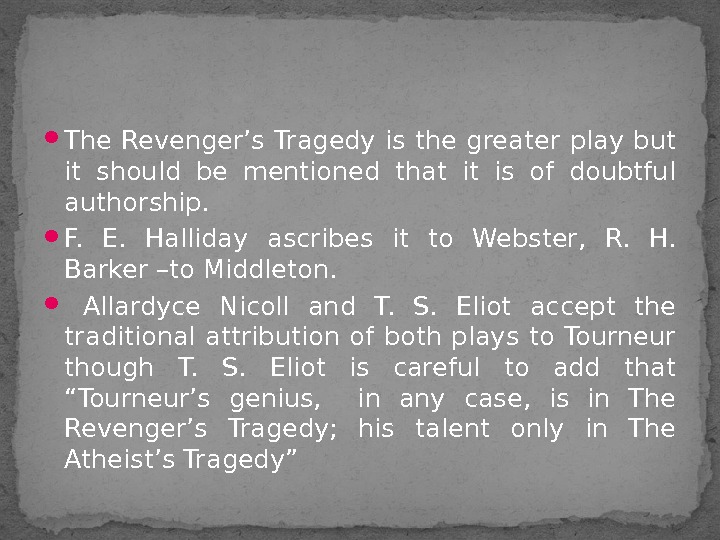
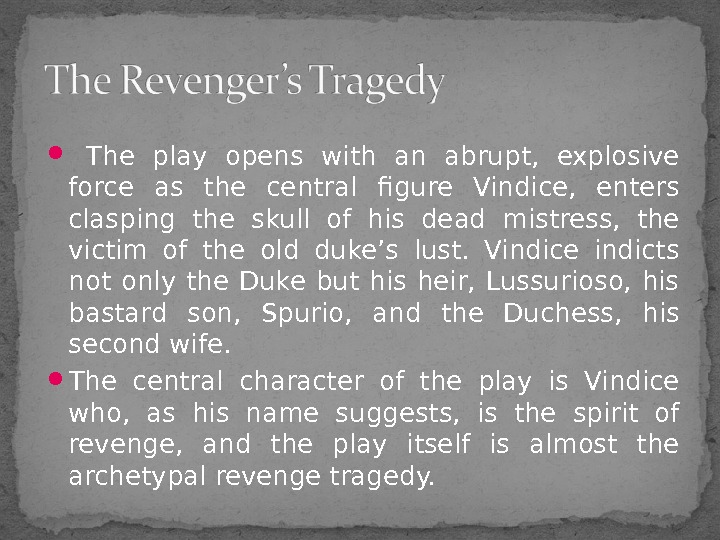
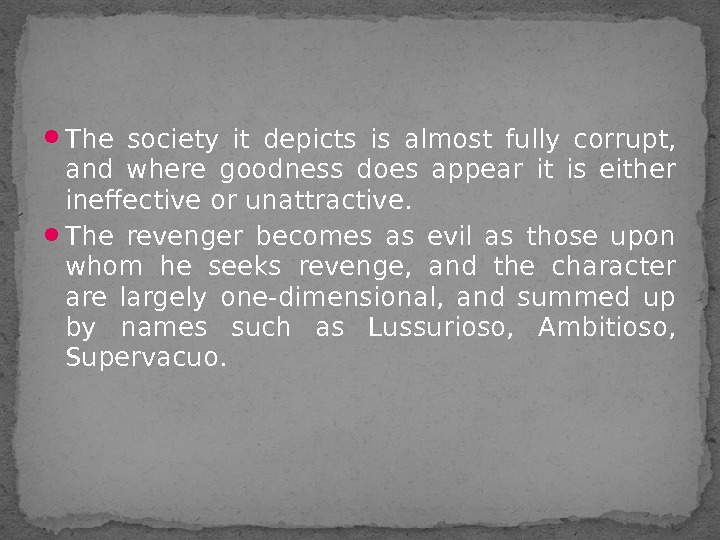
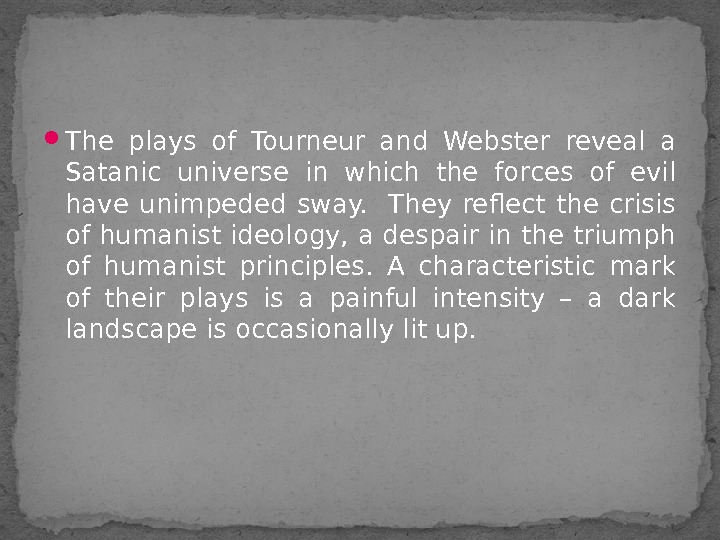
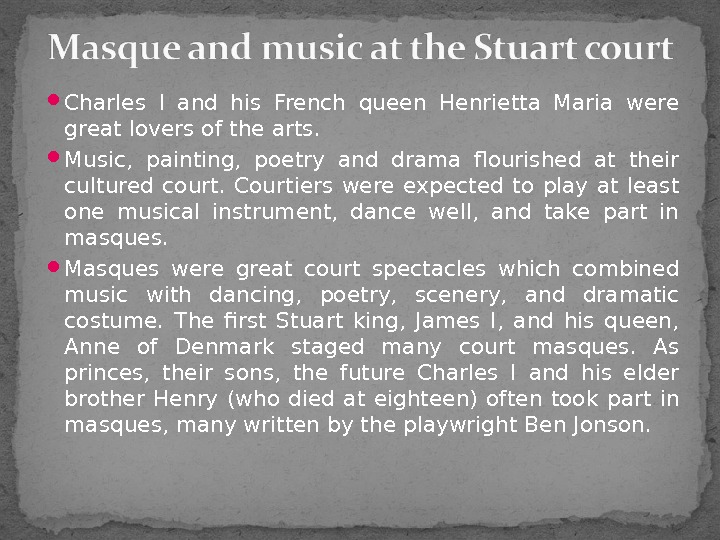
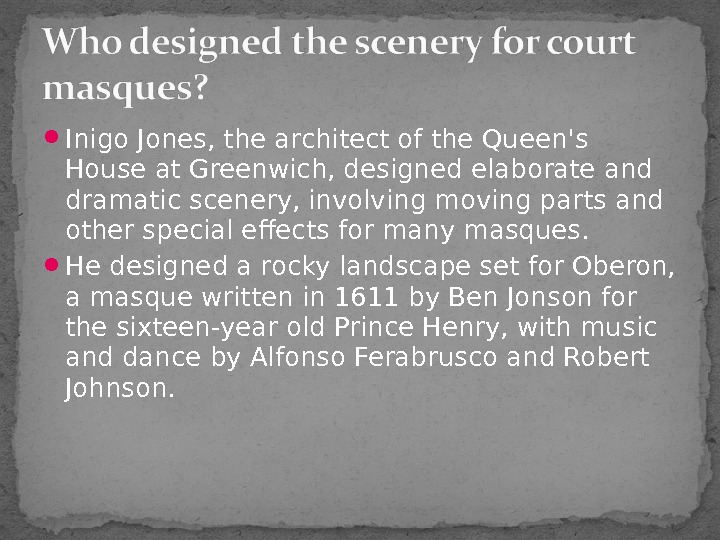
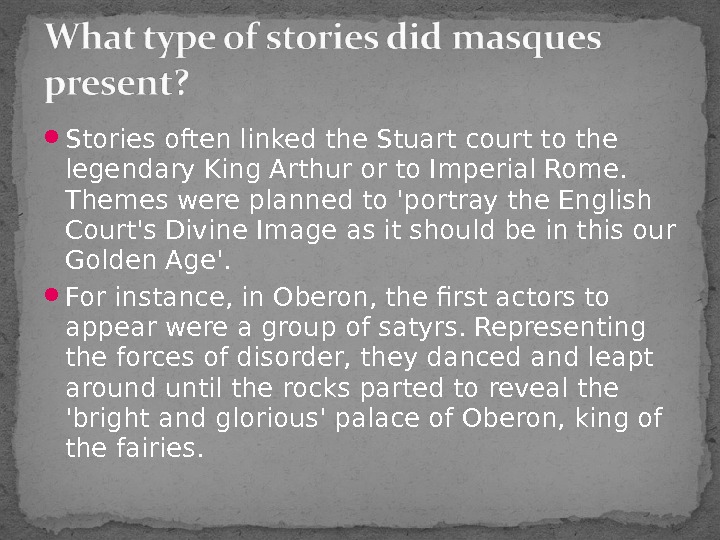
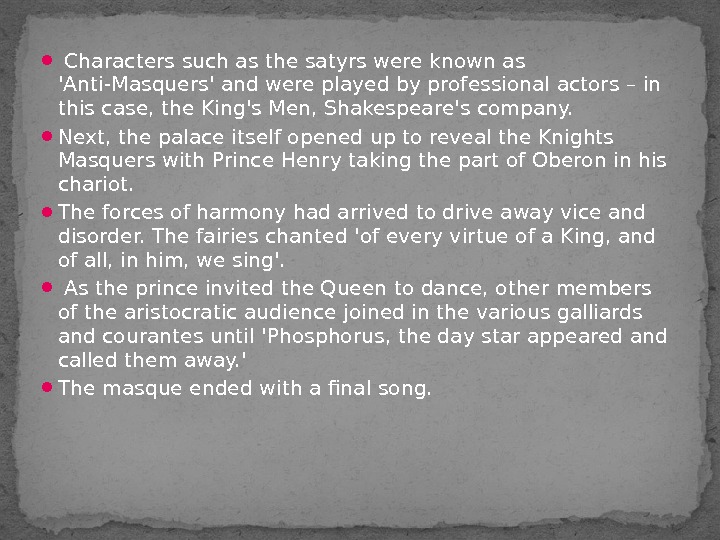
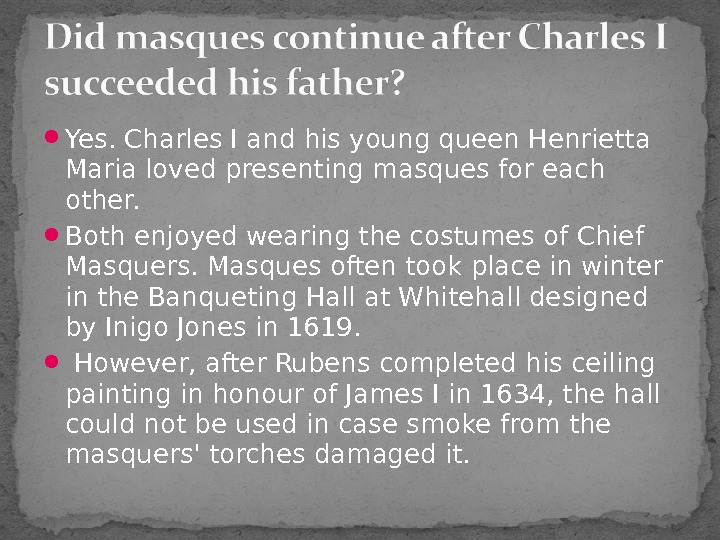
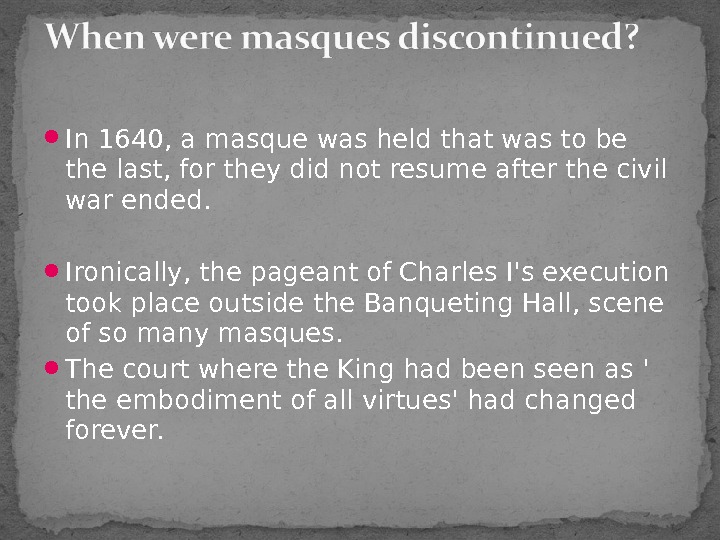
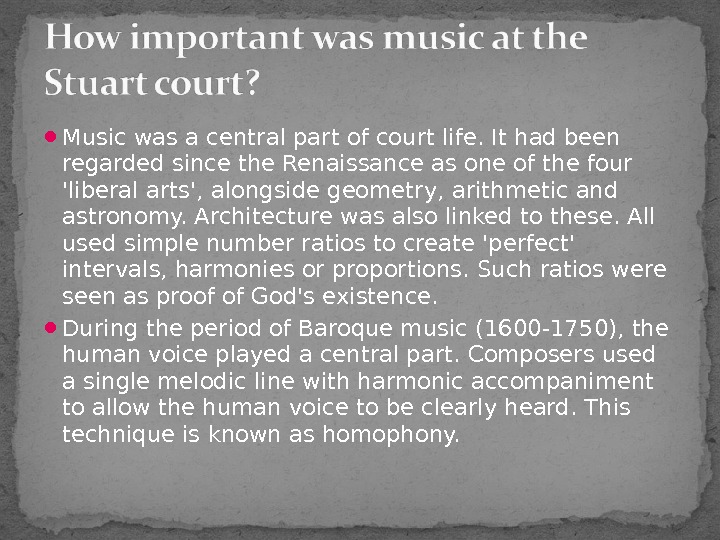
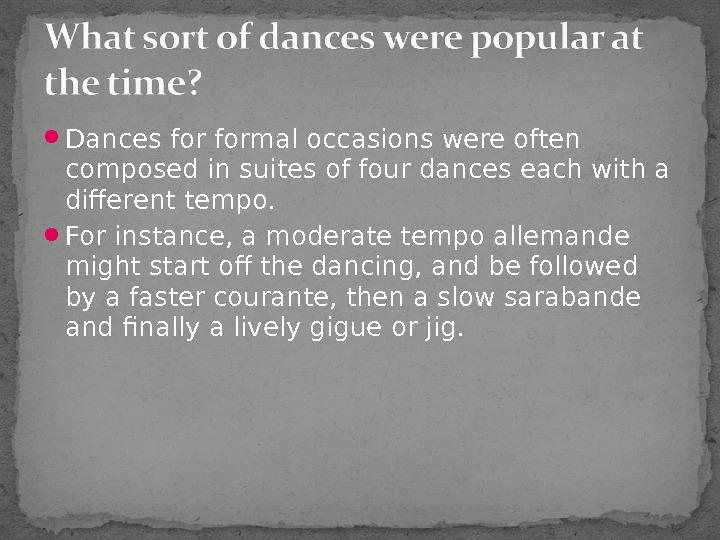

- Размер: 3.2 Mегабайта
- Количество слайдов: 87
Описание презентации Drama III/5. British drama came of age по слайдам
 Drama III/5.
Drama III/5.
 British drama came of age as James Burbage built the Theatre: — professional acting; — dramatic forms; — the drama of everyday life; — theatre-building fused in (bebiztosította) the late 1570 s to culminate in the majestic plays of Shakespeare and, a few years later, in those of the Jacobeans. One reason for this was the change in beliefs.
British drama came of age as James Burbage built the Theatre: — professional acting; — dramatic forms; — the drama of everyday life; — theatre-building fused in (bebiztosította) the late 1570 s to culminate in the majestic plays of Shakespeare and, a few years later, in those of the Jacobeans. One reason for this was the change in beliefs.
 The medieval Church and stage together had provided the necessary visions about the purpose of life. But in a politically conscious, mercantile, and affluent society (jóléti társadalom) , there was a need for new visions. It was the playwrights who now asked the relevant questions about the meaning of existence, taking the place of the Church, which led the Puritans to wage ceaseless war against the stage.
The medieval Church and stage together had provided the necessary visions about the purpose of life. But in a politically conscious, mercantile, and affluent society (jóléti társadalom) , there was a need for new visions. It was the playwrights who now asked the relevant questions about the meaning of existence, taking the place of the Church, which led the Puritans to wage ceaseless war against the stage.
 Dramatic form began to change. The old Interlude had a binary structure: most scenes had two characters only and, sometimes, only one who addressed the audience. Marlowe developed this structure so that one character was opposed to several figures acting as one, particularly in Tamburlain.
Dramatic form began to change. The old Interlude had a binary structure: most scenes had two characters only and, sometimes, only one who addressed the audience. Marlowe developed this structure so that one character was opposed to several figures acting as one, particularly in Tamburlain.
 John Lyly was an. Englishwriter, poet, dramatist, playwright, and politician, best known for his books Euphues, The Anatomy of Wit (1578) and Euphues and His England (1580). Lyly’s mannered literary style, originating in his first books, is known as euphuism ( an artificial, highly elaborate way of writing or speaking )
John Lyly was an. Englishwriter, poet, dramatist, playwright, and politician, best known for his books Euphues, The Anatomy of Wit (1578) and Euphues and His England (1580). Lyly’s mannered literary style, originating in his first books, is known as euphuism ( an artificial, highly elaborate way of writing or speaking )
 John Lyly authored prose narratives, plays for the private Elizabethan stage, and religious tracts. Born in Canterbury, Lyly attended King’s School, Canterbury, before matriculating at Magdalen College, Oxford, in 1569. He received his bachelor of arts in 1573 and his master of arts in 1575. He briefly pursued an academic career before turning to work under the patronage of Edward de Vere, earl of Oxford, for whom he served as secretary after 1580.
John Lyly authored prose narratives, plays for the private Elizabethan stage, and religious tracts. Born in Canterbury, Lyly attended King’s School, Canterbury, before matriculating at Magdalen College, Oxford, in 1569. He received his bachelor of arts in 1573 and his master of arts in 1575. He briefly pursued an academic career before turning to work under the patronage of Edward de Vere, earl of Oxford, for whom he served as secretary after 1580.
 Later, Lyly sat on four Parliaments, as the member for Hinden in 1589, for Aylesbury in 1593, for Appleby in 1597, and for Aylesbury in 1601. Lyly is best known for two of his prose narratives, Euphues: The Anatomy of Wit (1578) and Euphues and His England (1580), which served as stylistic models for English prose in the early 1580 s. Both use carefully structured sentences that rely heavily upon rhetorical figures such as antithesis, epigram, alliteration, and rhetorical questions.
Later, Lyly sat on four Parliaments, as the member for Hinden in 1589, for Aylesbury in 1593, for Appleby in 1597, and for Aylesbury in 1601. Lyly is best known for two of his prose narratives, Euphues: The Anatomy of Wit (1578) and Euphues and His England (1580), which served as stylistic models for English prose in the early 1580 s. Both use carefully structured sentences that rely heavily upon rhetorical figures such as antithesis, epigram, alliteration, and rhetorical questions.

 This style became very fashionable during the 1580 s and was ridiculed (nevetség tárgya) afterwards, especially in the 1590 s, but the continued popularity of Lyly’s work is reflected by their publication history, since : The Anatomy of Wit was reprinted nineteen times from 1578 to 1638, and Euphues and His England was published fourteen times from 1580 to 1609.
This style became very fashionable during the 1580 s and was ridiculed (nevetség tárgya) afterwards, especially in the 1590 s, but the continued popularity of Lyly’s work is reflected by their publication history, since : The Anatomy of Wit was reprinted nineteen times from 1578 to 1638, and Euphues and His England was published fourteen times from 1580 to 1609.
 Lyly also wrote his plays for the Boys’ Companies of the Blackfriars Theater beginning in 1583; these include Campaspe, Sappho and Phao, Galatea, Endymion, Midas, Love’s Metamorphosis, Mother Bombie , and The Woman in the Moon. Readers of religious controversies see Lyly’s authorship in controversial tracts; Gabriel Harvey attributed Pap with a Hatchet , one of the responses to Martin Marprelate, to Lyly; and other anti-Martinist tracts have been credited to Lyly, Thomas Nashe, or a team of the two.
Lyly also wrote his plays for the Boys’ Companies of the Blackfriars Theater beginning in 1583; these include Campaspe, Sappho and Phao, Galatea, Endymion, Midas, Love’s Metamorphosis, Mother Bombie , and The Woman in the Moon. Readers of religious controversies see Lyly’s authorship in controversial tracts; Gabriel Harvey attributed Pap with a Hatchet , one of the responses to Martin Marprelate, to Lyly; and other anti-Martinist tracts have been credited to Lyly, Thomas Nashe, or a team of the two.
 English dramatist who, with his The Spanish Tragedy (sometimes called Hieronimo, or Jeronimo , af t er its protagonist), initiated the revenge tragedy of his day. Kyd anticipated the structure of many later plays, including the development of middle and final climaxes. In addition, he revealed an instinctive sense of tragic situation, while his characterization of Hieronimo in The Spanish Tragedy prepared the way for Shakespeare’s psychological study of Hamlet.
English dramatist who, with his The Spanish Tragedy (sometimes called Hieronimo, or Jeronimo , af t er its protagonist), initiated the revenge tragedy of his day. Kyd anticipated the structure of many later plays, including the development of middle and final climaxes. In addition, he revealed an instinctive sense of tragic situation, while his characterization of Hieronimo in The Spanish Tragedy prepared the way for Shakespeare’s psychological study of Hamlet.

 The son of a scrivener, Kyd was educated at the Merchant Taylors School in London. There is no evidence that he attended the university before turning toliterature. He seems to have been in service for some years with a lord (possibly Ferdinando, Lord Strange, the patron of. Lord Strange’s Men). The Spanish Tragedy was entered in the Stationers’ Register in October 1592, and the undated first quarto edition almost certainly appeared in that year.
The son of a scrivener, Kyd was educated at the Merchant Taylors School in London. There is no evidence that he attended the university before turning toliterature. He seems to have been in service for some years with a lord (possibly Ferdinando, Lord Strange, the patron of. Lord Strange’s Men). The Spanish Tragedy was entered in the Stationers’ Register in October 1592, and the undated first quarto edition almost certainly appeared in that year.
 It is not known which company first played it, nor when; but Strange’s company played Hieronimo 16 times in 1592, and the. Admiral’s Menrevived it in 1597, as apparently did the. Chamberlain’s Men. It remained one of the most popular plays of the age and was often reprinted. The only other play certainly by Kyd is Cornelia (1594), an essay in. Senecan tragedy. He may also have written an earlier version of Hamlet, known to scholars as the Ur-Hamlet, and his hand has sometimes been detected in the anonymous Arden of Feversham, one of the first domestic tragedies, and in a number of other plays.
It is not known which company first played it, nor when; but Strange’s company played Hieronimo 16 times in 1592, and the. Admiral’s Menrevived it in 1597, as apparently did the. Chamberlain’s Men. It remained one of the most popular plays of the age and was often reprinted. The only other play certainly by Kyd is Cornelia (1594), an essay in. Senecan tragedy. He may also have written an earlier version of Hamlet, known to scholars as the Ur-Hamlet, and his hand has sometimes been detected in the anonymous Arden of Feversham, one of the first domestic tragedies, and in a number of other plays.
 About 1591 Kyd was sharing lodgings with. Christopher Marlowe, and on May 13, 1593, he was arrested and then tortured, being suspected of treasonable activity. His room had been searched and certain “atheistical” disputations denying the deity of Jesus Christ found there. He probably averred then and certainly confirmed later, in a letter, that these papers had belonged to Marlowe. That letter is the source for almost everything that is known about Kyd’s life. He was dead by Dec. 30, 1594, when his mother made a formal repudiation of her son’s debt-ridden estate.
About 1591 Kyd was sharing lodgings with. Christopher Marlowe, and on May 13, 1593, he was arrested and then tortured, being suspected of treasonable activity. His room had been searched and certain “atheistical” disputations denying the deity of Jesus Christ found there. He probably averred then and certainly confirmed later, in a letter, that these papers had belonged to Marlowe. That letter is the source for almost everything that is known about Kyd’s life. He was dead by Dec. 30, 1594, when his mother made a formal repudiation of her son’s debt-ridden estate.
 The play opens with a soliloquy of a ghost and continues into a tale of love and murder. Bellimperia exchanges vows with Horatio, son of Hieronimo; but her brother Lorenzo, having planned his si s ter for his friend Balthazar, hangs her lover in an arbor. Old Hieronimo finds his son dead and becomes deranged. He seeks revenge, and after many hesitating steps and delays, he entices his enemies to a play and murders them during the action.
The play opens with a soliloquy of a ghost and continues into a tale of love and murder. Bellimperia exchanges vows with Horatio, son of Hieronimo; but her brother Lorenzo, having planned his si s ter for his friend Balthazar, hangs her lover in an arbor. Old Hieronimo finds his son dead and becomes deranged. He seeks revenge, and after many hesitating steps and delays, he entices his enemies to a play and murders them during the action.
 Though The Spanish Tragedy was popular in its day, succeeding generations have found it extravagant and crude although a bold work. Its construction is episodic, but the tone is Senecan. It has a strong, well-developed plot; the scenes are varied and the stage effects excellently managed; and the climax of the play-within-a-play is exciting.
Though The Spanish Tragedy was popular in its day, succeeding generations have found it extravagant and crude although a bold work. Its construction is episodic, but the tone is Senecan. It has a strong, well-developed plot; the scenes are varied and the stage effects excellently managed; and the climax of the play-within-a-play is exciting.
 Around the turn of 16 th century, Shakespeare’s drama fell into neglect. He got eclipsed by Ben Johnson and his contemporaries. The Elizabethan drama of Shakespeare gave way to the Jacobian drama of Johnson. Beside Johnson, John Marston (1575 -1634), Thomas Middleton (1570 -1627), George Chapman (1559 -1634), Francis Beaumont (1584 -1616) John Fletcher (1579 -1625) and John Webster were the other dramatists of the age.
Around the turn of 16 th century, Shakespeare’s drama fell into neglect. He got eclipsed by Ben Johnson and his contemporaries. The Elizabethan drama of Shakespeare gave way to the Jacobian drama of Johnson. Beside Johnson, John Marston (1575 -1634), Thomas Middleton (1570 -1627), George Chapman (1559 -1634), Francis Beaumont (1584 -1616) John Fletcher (1579 -1625) and John Webster were the other dramatists of the age.
 Period of decline of the Renaissance; The 17 th century was the great century of English thinking and philosophy. The changes, the revolt and compromises were truly reflected in the poetry and prose of the first half of the century. But as far as drama is concerned, one can hardly expect to find any significant changes or striking innovations in theatre world of England as we pass from the 16 th century into the Jacobean period. The Elizabethan dramatic traditions even if no more than twenty years old, had been firmly established.
Period of decline of the Renaissance; The 17 th century was the great century of English thinking and philosophy. The changes, the revolt and compromises were truly reflected in the poetry and prose of the first half of the century. But as far as drama is concerned, one can hardly expect to find any significant changes or striking innovations in theatre world of England as we pass from the 16 th century into the Jacobean period. The Elizabethan dramatic traditions even if no more than twenty years old, had been firmly established.
 Shakespeare set the fashion in tragedy and romance, But an other ‘Elizabethan’, Ben Jonson d id the same in c o medy. The plebeian tradition of drama, too, appeared to be unbroken in the work of Dekker and Heywood. The playhouses, most of them built in the 16 th century, were still the same and the social composition of the audiences did not change during the first Jacobean decade.
Shakespeare set the fashion in tragedy and romance, But an other ‘Elizabethan’, Ben Jonson d id the same in c o medy. The plebeian tradition of drama, too, appeared to be unbroken in the work of Dekker and Heywood. The playhouses, most of them built in the 16 th century, were still the same and the social composition of the audiences did not change during the first Jacobean decade.
 The theatre could not keep away from the changing social, political and economic conditions for a long time, and certain elements of change began to present themselves within the Jacobean theatre. Whereas in Queen Elizabeth’s days it was the same theatre, the same play and also the same style of acting that was enjoyed by the spectators, b y the nobles, well-to-do citizens or underpaid artisans and apprentices, in the Jacobean time, on the other hand, something like a social and financial hierarchy was created in the world of theatre.
The theatre could not keep away from the changing social, political and economic conditions for a long time, and certain elements of change began to present themselves within the Jacobean theatre. Whereas in Queen Elizabeth’s days it was the same theatre, the same play and also the same style of acting that was enjoyed by the spectators, b y the nobles, well-to-do citizens or underpaid artisans and apprentices, in the Jacobean time, on the other hand, something like a social and financial hierarchy was created in the world of theatre.
 T he distance between the tastes and demands of the upper classes and of those of the lower section of the population became fairly distinct. The repertoires as well as the admissions of the playhouses, favoured by the lower social strata also became different from those of the private theatres, whose patrons came from the upper classes.
T he distance between the tastes and demands of the upper classes and of those of the lower section of the population became fairly distinct. The repertoires as well as the admissions of the playhouses, favoured by the lower social strata also became different from those of the private theatres, whose patrons came from the upper classes.
 These private theatres enjoyed a higher social status, and did their best to satisfy the demands of their moneyed audiences. The conclusion is that something like two cultures, sharply separated from each other, were gradually taking shape in the Jacobean theatre. The reason why the popular theatre of the first four decades of the 17 th century could not function as a sort of revolutionary forum is partly to be sought in the longstanding hostilities between the actors’ companies and the Puritans.
These private theatres enjoyed a higher social status, and did their best to satisfy the demands of their moneyed audiences. The conclusion is that something like two cultures, sharply separated from each other, were gradually taking shape in the Jacobean theatre. The reason why the popular theatre of the first four decades of the 17 th century could not function as a sort of revolutionary forum is partly to be sought in the longstanding hostilities between the actors’ companies and the Puritans.
 In accordance with the Puritan views all forms of merrymaking, dances, singing, and most especially, theatres were sinful, the Puritans had never ceased to launch fierce attacks on theatres, players even in the Elizabethan time. Much was changed when in the second decade of James’ reign, the Puritans’ moral norms became widely accepted and identified as the revolutionary ideology of the middle-classes
In accordance with the Puritan views all forms of merrymaking, dances, singing, and most especially, theatres were sinful, the Puritans had never ceased to launch fierce attacks on theatres, players even in the Elizabethan time. Much was changed when in the second decade of James’ reign, the Puritans’ moral norms became widely accepted and identified as the revolutionary ideology of the middle-classes
 The immorality and sinfulness of the playhouses, irrespective of being popular or private, were attacked in pamphlets and from the pulpit, and every respectable citizen felt it his duty to abandon theatres. The turnover of the audience was not too large, the plays would seldom be performed on more than three successive nights, and as it was the same gentlemen-about-town who went to see the performances, there had to be a new play on as often as possible. By the 1640 s the number of theatres increased, dramatists had to provide plays for six London theatres. They could do it only by inve n ting plots or taking them wherever they could find, so they turned to the evergreen collec t ions of fables and stories of e a rlier days.
The immorality and sinfulness of the playhouses, irrespective of being popular or private, were attacked in pamphlets and from the pulpit, and every respectable citizen felt it his duty to abandon theatres. The turnover of the audience was not too large, the plays would seldom be performed on more than three successive nights, and as it was the same gentlemen-about-town who went to see the performances, there had to be a new play on as often as possible. By the 1640 s the number of theatres increased, dramatists had to provide plays for six London theatres. They could do it only by inve n ting plots or taking them wherever they could find, so they turned to the evergreen collec t ions of fables and stories of e a rlier days.
 In 1642 London theatres, long frowned upon by the Puritans, were closed by Act of Parliament and dramatic performances practically ceased in London for fourteen years. A good number of theatrical novelties were introduced with the full restoration of theatres in 1660, but even these innovations were closely linked to the traditions initiated by the Elizabethans and the early Stuart playwrights. Seen in this light, the Jacobean and Caroline period in the history of English drama is to be considered as a period of transition and also of deterioration culminating in the 18 th century
In 1642 London theatres, long frowned upon by the Puritans, were closed by Act of Parliament and dramatic performances practically ceased in London for fourteen years. A good number of theatrical novelties were introduced with the full restoration of theatres in 1660, but even these innovations were closely linked to the traditions initiated by the Elizabethans and the early Stuart playwrights. Seen in this light, the Jacobean and Caroline period in the history of English drama is to be considered as a period of transition and also of deterioration culminating in the 18 th century
 (At birth he got the name Benjamin, but he never used it. He used the name Ben). Jonson was in almost every respect the artistic opposite of Shakespeare represents the fullness of the Renaissance spirit, he is the finest flower of the Elizabethan age. He studied at Westminster School under William Camden, the famous antiquary. It was there that Jonson laid the foundations of his comprehensive classical learning; with George Chapman, he was the most learned of the English Renaissance dramatists.
(At birth he got the name Benjamin, but he never used it. He used the name Ben). Jonson was in almost every respect the artistic opposite of Shakespeare represents the fullness of the Renaissance spirit, he is the finest flower of the Elizabethan age. He studied at Westminster School under William Camden, the famous antiquary. It was there that Jonson laid the foundations of his comprehensive classical learning; with George Chapman, he was the most learned of the English Renaissance dramatists.
 After Abraham van Blyenberch, 1618. © National Portrait Gallery , London.
After Abraham van Blyenberch, 1618. © National Portrait Gallery , London.
 His first popular success was in the field of comedy. He left behind 17 plays, 35 other dramatic pieces (masques and entertainments) , a number of poems and epigrams original and translated, an English grammar, and a commonplace book called Timber, or Discoveries The standard edition of Jonson is by C. Herford and P. Simpson, in 11 volumes.
His first popular success was in the field of comedy. He left behind 17 plays, 35 other dramatic pieces (masques and entertainments) , a number of poems and epigrams original and translated, an English grammar, and a commonplace book called Timber, or Discoveries The standard edition of Jonson is by C. Herford and P. Simpson, in 11 volumes.
 Jonson’s dramatic technique differs from that of his contemporaries. He invented his stories and prided himself of his originality. Moreover, he followed neoclassical ideals and carefully avoided absurdities in his work. Jonson consciously employed a realistic technique of presentation.
Jonson’s dramatic technique differs from that of his contemporaries. He invented his stories and prided himself of his originality. Moreover, he followed neoclassical ideals and carefully avoided absurdities in his work. Jonson consciously employed a realistic technique of presentation.
 In his comedy Jonson presents a satirical survey of human characteristics. People are usually depicted in ‘humours’, with the emphasis on a ruling trait or passion, and are subjected to a judicious review (alapos, megfontolt áttekintés). Jonson’s great powers of mind were turned to a devastating criticism of the acquisitive (kapzsi) society in Volpone , acted early in 1606. The evils of the new bourgeois order are examined here from the viewpoint of popular humanism. T he corrupting power of wealth became one of the main themes of drama after 1600.
In his comedy Jonson presents a satirical survey of human characteristics. People are usually depicted in ‘humours’, with the emphasis on a ruling trait or passion, and are subjected to a judicious review (alapos, megfontolt áttekintés). Jonson’s great powers of mind were turned to a devastating criticism of the acquisitive (kapzsi) society in Volpone , acted early in 1606. The evils of the new bourgeois order are examined here from the viewpoint of popular humanism. T he corrupting power of wealth became one of the main themes of drama after 1600.
 The theme of Volpone is the degrading effect of money on human character. The morality tradition is clearly visible in the structure of the play and the nomenclature of the figures. Jonson brings home his point by the method of dehumanization : the characters of the play are given the names of birds of prey, animals of lower order, thus underlining the fact that the main agents of the action are animated by the basest instincts, not by intelligence or natural morality. Voltore — the vulture (keselyű) , Corbaccio — the raven, Corvino — the crow, they all fall victims to the wiles (csábítás) of Volpone — the crafty fox and his parasite, Mosca, the fly.
The theme of Volpone is the degrading effect of money on human character. The morality tradition is clearly visible in the structure of the play and the nomenclature of the figures. Jonson brings home his point by the method of dehumanization : the characters of the play are given the names of birds of prey, animals of lower order, thus underlining the fact that the main agents of the action are animated by the basest instincts, not by intelligence or natural morality. Voltore — the vulture (keselyű) , Corbaccio — the raven, Corvino — the crow, they all fall victims to the wiles (csábítás) of Volpone — the crafty fox and his parasite, Mosca, the fly.
 They all commit perjury (hamis tanúzás). Corbaccio disinherits his son and accuses him of intended murder; Corvino the jealous husband, is ready to prostitute his wife to Volpone’s lust, in order to secure his inheritance. Depths below depths of evil open up in the course of the brilliantly complicated plot. The profanation (megszentségtelenítés) of moral values is stressed by the imagery of the play: money, food, sensual pleasure are invented with divine qualities.
They all commit perjury (hamis tanúzás). Corbaccio disinherits his son and accuses him of intended murder; Corvino the jealous husband, is ready to prostitute his wife to Volpone’s lust, in order to secure his inheritance. Depths below depths of evil open up in the course of the brilliantly complicated plot. The profanation (megszentségtelenítés) of moral values is stressed by the imagery of the play: money, food, sensual pleasure are invented with divine qualities.
 After the Prologue, the play opens with Volpone’s sacrilegious (szentségtörő 9 hymn to gold, an example of the perversion of value, the voice of a society in which the unscrupulous (gátlástalan) quest for money has become man’s religion. “ Good morning to the day; and next, my gold!-“
After the Prologue, the play opens with Volpone’s sacrilegious (szentségtörő 9 hymn to gold, an example of the perversion of value, the voice of a society in which the unscrupulous (gátlástalan) quest for money has become man’s religion. “ Good morning to the day; and next, my gold!-“
 Volpone was written by a master of stage effects – firmness of construction is one of the main sources of aesthetic pleasure in Jonson. His style is different from Shakespeare’s which is characterized by suggestiveness, the interplay of thought and emotion. In Jonson everything is said deliberately and with the greatest economy.
Volpone was written by a master of stage effects – firmness of construction is one of the main sources of aesthetic pleasure in Jonson. His style is different from Shakespeare’s which is characterized by suggestiveness, the interplay of thought and emotion. In Jonson everything is said deliberately and with the greatest economy.
 In Volpone Jonson achieved his greatest artistic effect though The Alchemist (1610) is even more perfect in its artistry. The central figure is Sir Epicure Mammon, a Marlow — esque figure with an exuberant sensual imagination who is looking for the philosopher’s stone that would change all metal go gold. Act II, scene 1 gives expression to his impassioned waking dreams, full of details of the alchemists’ lore (tan, tudomány).
In Volpone Jonson achieved his greatest artistic effect though The Alchemist (1610) is even more perfect in its artistry. The central figure is Sir Epicure Mammon, a Marlow — esque figure with an exuberant sensual imagination who is looking for the philosopher’s stone that would change all metal go gold. Act II, scene 1 gives expression to his impassioned waking dreams, full of details of the alchemists’ lore (tan, tudomány).
 Mammon : I have a place of Jason’s fleece, too, Which was no other than a book of alchemy, Writ in large ship-skin, a good fat ram-vellum. Such was Pythagoras’ thigh, Pandora’s tub, And, all that fable of Medea’s charms, The manner of our work; the bulls, our furnace, Still breathing fire; our argent-vive, the dragon: The dragon’s teeth, mercury sublimate. My meat shall come in, in Indian shells, Dishes of agate set in gold, and studded With emeralds, sapphires; hyacinths, and rubies. The tongues of carps, dormice, and camels’ heels, Boil’d in the spirit of sol, and dissolv’d pearl, Apicius’ diet, ‘gainst the epilepsy: And I will eat these broths with spoons of amber, Headed with diamond and carbuncule.
Mammon : I have a place of Jason’s fleece, too, Which was no other than a book of alchemy, Writ in large ship-skin, a good fat ram-vellum. Such was Pythagoras’ thigh, Pandora’s tub, And, all that fable of Medea’s charms, The manner of our work; the bulls, our furnace, Still breathing fire; our argent-vive, the dragon: The dragon’s teeth, mercury sublimate. My meat shall come in, in Indian shells, Dishes of agate set in gold, and studded With emeralds, sapphires; hyacinths, and rubies. The tongues of carps, dormice, and camels’ heels, Boil’d in the spirit of sol, and dissolv’d pearl, Apicius’ diet, ‘gainst the epilepsy: And I will eat these broths with spoons of amber, Headed with diamond and carbuncule.
 But this lyric yearning (lírai sóvárgás) is set by Jonson into comic perspectives. The ironic imagery, the hyperbolic excesses of the style lift the action to the plane of caricature. The knight becomes an easy prey in the hands of Subtle, the alchemist, and his associates. Jonson is again managing a complex plot with superb skill. He is writing a superb satire on human credulity (hiszékenység) as well as on rapacity (kapzsiság) and the lust (vágy) of gold in which he saw the chief evils of his age.
But this lyric yearning (lírai sóvárgás) is set by Jonson into comic perspectives. The ironic imagery, the hyperbolic excesses of the style lift the action to the plane of caricature. The knight becomes an easy prey in the hands of Subtle, the alchemist, and his associates. Jonson is again managing a complex plot with superb skill. He is writing a superb satire on human credulity (hiszékenység) as well as on rapacity (kapzsiság) and the lust (vágy) of gold in which he saw the chief evils of his age.
 Jonson’s technique is essentially that of late Renaissance or Baroque art, with many features that remind one of Milton, while in the fundamental meaning of his work, in his ‘popular humanism’ he joins hands with Shakespeare. The manner of representing life in Bartholomew Fair brings him close to the ‘plebeian realism’ of Dekker and Heywood.
Jonson’s technique is essentially that of late Renaissance or Baroque art, with many features that remind one of Milton, while in the fundamental meaning of his work, in his ‘popular humanism’ he joins hands with Shakespeare. The manner of representing life in Bartholomew Fair brings him close to the ‘plebeian realism’ of Dekker and Heywood.
 Thomas Dekker is noted also as a pamphleteer, “the first literary artist of London street life”. Dekker was interested in the darker aspects of London life which gave him an opportunity for the display of his humanitarian spirit. Dekker’s two earliest plays, both published in 1600, indicate the two contrasted strains of his art.
Thomas Dekker is noted also as a pamphleteer, “the first literary artist of London street life”. Dekker was interested in the darker aspects of London life which gave him an opportunity for the display of his humanitarian spirit. Dekker’s two earliest plays, both published in 1600, indicate the two contrasted strains of his art.
 Old Fortunatus , based on a German folk-tale, is a charming but loosely constructed poetical piece full of nebulous romantic motifs. The Shoemaker’s Holiday represents a complete contrast in its skilful plot-construction and realistic characterization. The play is full of vigorous (élénk) , jovial life; Simon Eyre is one of the most vital figures in Elizabethan comedy. He takes pride in his profession and keeps repeating: ”Prince am I none, yet am I nobly born, as being the sole son of a shoemaker. ”
Old Fortunatus , based on a German folk-tale, is a charming but loosely constructed poetical piece full of nebulous romantic motifs. The Shoemaker’s Holiday represents a complete contrast in its skilful plot-construction and realistic characterization. The play is full of vigorous (élénk) , jovial life; Simon Eyre is one of the most vital figures in Elizabethan comedy. He takes pride in his profession and keeps repeating: ”Prince am I none, yet am I nobly born, as being the sole son of a shoemaker. ”
 By a stroke of fortune he suddenly becomes rich, is elected sheriff of the city and finally Lord Mayor – yet he never forget his workmen. When the King comes to dine with him, Sim Eyre entertains also his fellow prentices of London. Incidents like these show that, like the realistic pamphlets and stories, Dekker’s play was written to please the urban tradesman.
By a stroke of fortune he suddenly becomes rich, is elected sheriff of the city and finally Lord Mayor – yet he never forget his workmen. When the King comes to dine with him, Sim Eyre entertains also his fellow prentices of London. Incidents like these show that, like the realistic pamphlets and stories, Dekker’s play was written to please the urban tradesman.
 The realistic scenes are intertwined with two love-stories; the life of tradesmen, journeymen apprentices is portrayed in conjunction with the life of the upper classes. This manner of presentation has earned the enthusiastic praise of Ernest Rhys, in his Introduction to the Mermaid edition of Dekker’s plays: The Shoemaker’s Holiday “displays all that genial interest in everything human, all that ready democratic sympathy, which, among Elizabethans, Dekker has peculiarly displayed.
The realistic scenes are intertwined with two love-stories; the life of tradesmen, journeymen apprentices is portrayed in conjunction with the life of the upper classes. This manner of presentation has earned the enthusiastic praise of Ernest Rhys, in his Introduction to the Mermaid edition of Dekker’s plays: The Shoemaker’s Holiday “displays all that genial interest in everything human, all that ready democratic sympathy, which, among Elizabethans, Dekker has peculiarly displayed.
 The comedy is indeed the most perfect presentation of the brightness and social interest of the everyday Elizabethan life which is to be found in the English drama. It realizes with admirable vividness certain simpler types of character, of which the people, as opposed to the aristocratic classes from which most of the dramatists drew their characters, were formed. ”
The comedy is indeed the most perfect presentation of the brightness and social interest of the everyday Elizabethan life which is to be found in the English drama. It realizes with admirable vividness certain simpler types of character, of which the people, as opposed to the aristocratic classes from which most of the dramatists drew their characters, were formed. ”
 Rhys touches here on the fundamental difference between the realism of Jonson and Dekker: the method of the former is satiric, of the latter, sympathetic. Dekker’s chief attraction lies in his broad humanitarian attitude towards life, in his loving descriptions of the lower world of London. “ He is a sentimental realist who, instead of seeking with the satirist for the vices of life, searches for the good”.
Rhys touches here on the fundamental difference between the realism of Jonson and Dekker: the method of the former is satiric, of the latter, sympathetic. Dekker’s chief attraction lies in his broad humanitarian attitude towards life, in his loving descriptions of the lower world of London. “ He is a sentimental realist who, instead of seeking with the satirist for the vices of life, searches for the good”.
 Satire is not entirely missing from Dekker’s armoury. His next play published in 1602, was Satiromastix , part of the “Poetomachia’ or War of the Theatres. It contains a famous burlesque on Ben Jonson who is presented as a dogmatic, conceited (öntelt) versifier who tries to write with the aid of a rhyming-dictionary. Dekker’s other achievements lay in the field of domestic tragedy, a type of drama initiated by Arden of Feversham (1592) and other plays, mainly based on recent murders, including A Warning for Fair Women (printed in 1599) and A Yorkshire Tragedy (c. 1606)
Satire is not entirely missing from Dekker’s armoury. His next play published in 1602, was Satiromastix , part of the “Poetomachia’ or War of the Theatres. It contains a famous burlesque on Ben Jonson who is presented as a dogmatic, conceited (öntelt) versifier who tries to write with the aid of a rhyming-dictionary. Dekker’s other achievements lay in the field of domestic tragedy, a type of drama initiated by Arden of Feversham (1592) and other plays, mainly based on recent murders, including A Warning for Fair Women (printed in 1599) and A Yorkshire Tragedy (c. 1606)
 With Dekker and Heywood we reach a new variety of domestic drama: attempts at the expression of social problems and the portrayal of real human characters. Dekker’s masterpiece in this kind is The Honest Whore , the first part of which was printed in 1604, while Part II was written a quarter of a century later. The play deals with problems that arise out of marital infidelity. The title figure is the harlot Bellafront who is redeemed from her life of sin by the power of love. In Part II the outstanding figure is Bellafront’s father, Orlando Friscobaldo. He is the subject of a famous criticism by Hazlitt.
With Dekker and Heywood we reach a new variety of domestic drama: attempts at the expression of social problems and the portrayal of real human characters. Dekker’s masterpiece in this kind is The Honest Whore , the first part of which was printed in 1604, while Part II was written a quarter of a century later. The play deals with problems that arise out of marital infidelity. The title figure is the harlot Bellafront who is redeemed from her life of sin by the power of love. In Part II the outstanding figure is Bellafront’s father, Orlando Friscobaldo. He is the subject of a famous criticism by Hazlitt.
 Thomas Heywood was noted for his many-sidedness and versatility (sokoldalúság) Lamb called him a ‘prose Shakespeare’. Of all the playwrights of the period Heywood was the most prolific. In the Preface to The English Traveller (1633) he stated that he had “either an entire hand or at least a main finger” in 220 plays. They include historical dramas, comedies of English life, dramatisations of classical legend, domestic tragedies, and romances.
Thomas Heywood was noted for his many-sidedness and versatility (sokoldalúság) Lamb called him a ‘prose Shakespeare’. Of all the playwrights of the period Heywood was the most prolific. In the Preface to The English Traveller (1633) he stated that he had “either an entire hand or at least a main finger” in 220 plays. They include historical dramas, comedies of English life, dramatisations of classical legend, domestic tragedies, and romances.
 The Four Prentices of London , Heywood’s earliest extant play (1592), belongs to the last type. Its heroes are the four sons of the Duke of Boulogne. Their father has been dispossessed by the French king and is living in London as a private citizen and has apprenticed his four sons to different trades. The sons set out for the Holy Land win their laurel in the first Crusade. The play combines different elements, such as pictures of London life, wildly romantic adventures by sea and land, and a historical background.
The Four Prentices of London , Heywood’s earliest extant play (1592), belongs to the last type. Its heroes are the four sons of the Duke of Boulogne. Their father has been dispossessed by the French king and is living in London as a private citizen and has apprenticed his four sons to different trades. The sons set out for the Holy Land win their laurel in the first Crusade. The play combines different elements, such as pictures of London life, wildly romantic adventures by sea and land, and a historical background.
 In the Introduction to the Mermaid edition of Heywood’s plays, John Addington Symonds wonders if this absurd play was intended for a parody of chivalrous romances, like Beaumont’s Knight of the Burning Pestle, or if it was meant for a hyperbolical compliment to the courage of the London apprentices. He regards the latter as the more probable supposition.
In the Introduction to the Mermaid edition of Heywood’s plays, John Addington Symonds wonders if this absurd play was intended for a parody of chivalrous romances, like Beaumont’s Knight of the Burning Pestle, or if it was meant for a hyperbolical compliment to the courage of the London apprentices. He regards the latter as the more probable supposition.
 But Heywood’s greatest achievement is undoubtedly in the field of domestic drama. His best known plays in this kind are The English Traveller , with a subplot borrowed from Plautus, and, chief of all, Heywood’s masterpiece, A Woman Killed with Kindness , “ the finest bourgeois tragedy of Elizabethan literature”
But Heywood’s greatest achievement is undoubtedly in the field of domestic drama. His best known plays in this kind are The English Traveller , with a subplot borrowed from Plautus, and, chief of all, Heywood’s masterpiece, A Woman Killed with Kindness , “ the finest bourgeois tragedy of Elizabethan literature”
 In this play Heywood drew neither from romantic imaginings nor from classical sources. He concentrated on a simple domestic situation set in the background of a Yorkshire country house. Its owner, Frankford, is happily married until he receives into his house a friend of broken means who seduces his wife. The husband suspects nothing but his old servant breaks the truth to him. Frankford pretends to leave for a journey but returns at night to find his wife in his friend’s embrace.
In this play Heywood drew neither from romantic imaginings nor from classical sources. He concentrated on a simple domestic situation set in the background of a Yorkshire country house. Its owner, Frankford, is happily married until he receives into his house a friend of broken means who seduces his wife. The husband suspects nothing but his old servant breaks the truth to him. Frankford pretends to leave for a journey but returns at night to find his wife in his friend’s embrace.
 Instead of killing them both, as the conventions of ordinary tragedy would have demanded, he sends his wife to live in seclusion in a lonely manor. But the wife is humbled to dust by her husband’s kindness, will not have food or drink or sleep, and, dying, sends for h er. The play ends with a scene of reconciliation.
Instead of killing them both, as the conventions of ordinary tragedy would have demanded, he sends his wife to live in seclusion in a lonely manor. But the wife is humbled to dust by her husband’s kindness, will not have food or drink or sleep, and, dying, sends for h er. The play ends with a scene of reconciliation.
 Both dramatists came from the higher strata of society. Beaumont was Shakespeare’s junior by twenty years but died in the same year as the older dramatist, at the age of 32. He was the son of a judge and was buried in the Westminster Abbey.
Both dramatists came from the higher strata of society. Beaumont was Shakespeare’s junior by twenty years but died in the same year as the older dramatist, at the age of 32. He was the son of a judge and was buried in the Westminster Abbey.
 A collection of thirty-four plays was published in 1647 under the names of Beaumont and Fletcher , the number was increased to fifty-two in the second Folio (1679). The problem of the authorship of the so-called Beaumont and Fletcher plays belongs to the most controversial questions. The spirit and attitude in these plays mark a significant change in English Renaissance drama.
A collection of thirty-four plays was published in 1647 under the names of Beaumont and Fletcher , the number was increased to fifty-two in the second Folio (1679). The problem of the authorship of the so-called Beaumont and Fletcher plays belongs to the most controversial questions. The spirit and attitude in these plays mark a significant change in English Renaissance drama.
 Shakespeare’s stories are often silly and improbable, yet he tells them without violently offending against truth of character or the truth of life. His plays reveal something essential about man and life. By contrast, the Beaumont and Fletcher plays are saturated with moral unconcern: they present a chain of exciting events designed to produce the maximum of emotional effect. The moral basis has been replaced here by an emotional scale of value.
Shakespeare’s stories are often silly and improbable, yet he tells them without violently offending against truth of character or the truth of life. His plays reveal something essential about man and life. By contrast, the Beaumont and Fletcher plays are saturated with moral unconcern: they present a chain of exciting events designed to produce the maximum of emotional effect. The moral basis has been replaced here by an emotional scale of value.
 The structure of their plays is extremely skilful. The dramatic material is constructed into theatrically telling situations which lead by a series of surprises to effective climaxes and catastrophes. The characters belong to certain conventional types, such as the sentimental or violent hero; his faithful friend, a blunt (tompa) , outspoken (szókimondó) soldier; the sentimental heroine, often a love-lorn maiden disguised as a page to serve the hero; an evil woman defiant (dacos) in her crimes. The theme is often the struggle between love and honour, with high flown ideas of friendship between man and man. Such stock characters and situations foreshadow some of the basic subjects of the heroic drama of the Restoration comedy.
The structure of their plays is extremely skilful. The dramatic material is constructed into theatrically telling situations which lead by a series of surprises to effective climaxes and catastrophes. The characters belong to certain conventional types, such as the sentimental or violent hero; his faithful friend, a blunt (tompa) , outspoken (szókimondó) soldier; the sentimental heroine, often a love-lorn maiden disguised as a page to serve the hero; an evil woman defiant (dacos) in her crimes. The theme is often the struggle between love and honour, with high flown ideas of friendship between man and man. Such stock characters and situations foreshadow some of the basic subjects of the heroic drama of the Restoration comedy.
 Many attempts have been made to separate the work of the two playwrights. Some suggest that Beaumont supplied ‘judgment’ and checked his friend’s exuberance of ‘wit. ’ The usual view was that Beaumont is the deeper, more tragic author whose architectonic gift imposed discipline on Fletcher’s fluency.
Many attempts have been made to separate the work of the two playwrights. Some suggest that Beaumont supplied ‘judgment’ and checked his friend’s exuberance of ‘wit. ’ The usual view was that Beaumont is the deeper, more tragic author whose architectonic gift imposed discipline on Fletcher’s fluency.
 But Beaumont was also a master of the burlesque as is shown by the delightful play, The Knight of the Burning Pestle, usually assigned to Beaumont alone. It is an outpouring of his spirits, composed in eight days in 1607 or 1610, and performed by boy actors.
But Beaumont was also a master of the burlesque as is shown by the delightful play, The Knight of the Burning Pestle, usually assigned to Beaumont alone. It is an outpouring of his spirits, composed in eight days in 1607 or 1610, and performed by boy actors.
 In The Knight of the Burning Pestle , Beaumont created two audience members who move their seats to the stage to watch the play. This presents the convention of private theatres that began at the Blackfriars Playhouse that involved gentlemen actually sitting on the stage during a performance. These viewers paid more money to see the play and, more importantly, to be seen by the other audience members. However, though the owners of the playhouses insisted they allow these men to watch the show from the stage, most scholars believe that actors and dramatists did not like the new custom at all.
In The Knight of the Burning Pestle , Beaumont created two audience members who move their seats to the stage to watch the play. This presents the convention of private theatres that began at the Blackfriars Playhouse that involved gentlemen actually sitting on the stage during a performance. These viewers paid more money to see the play and, more importantly, to be seen by the other audience members. However, though the owners of the playhouses insisted they allow these men to watch the show from the stage, most scholars believe that actors and dramatists did not like the new custom at all.
 In The Knight of the Burning Pestle, which was written for the Blackfriars Playhouse, George and Nell climb onto the stage to join the gentlemen who are already on stage viewing the play. In this play, Beaumont not only mocks audience members but particularly those who paid money to view the play from the stage. This placement of the citizen and his wife is most significant though because it further satirizes, and quite blatantly (nyilvánvalóan) , the audience member who does not understand the fiction of theatre, as neither George nor Nell cannot theoretically cross the boundary between stage and audience even though they have physically crossed it.
In The Knight of the Burning Pestle, which was written for the Blackfriars Playhouse, George and Nell climb onto the stage to join the gentlemen who are already on stage viewing the play. In this play, Beaumont not only mocks audience members but particularly those who paid money to view the play from the stage. This placement of the citizen and his wife is most significant though because it further satirizes, and quite blatantly (nyilvánvalóan) , the audience member who does not understand the fiction of theatre, as neither George nor Nell cannot theoretically cross the boundary between stage and audience even though they have physically crossed it.
 The Knight of the Burning Pestle similarly, if not much more definitively, explores this idea that audience members mistake fiction for reality. Though most plays had previously employed the actors to challenge the barrier between fiction and reality, Beaumont breaks this theatrical convention with his immediate introduction of the characters of George and Nell. By creating characters who are audience members, Beaumont allows for the possibility of observing their understanding of the play, the idea of fiction, and their perception of reality.
The Knight of the Burning Pestle similarly, if not much more definitively, explores this idea that audience members mistake fiction for reality. Though most plays had previously employed the actors to challenge the barrier between fiction and reality, Beaumont breaks this theatrical convention with his immediate introduction of the characters of George and Nell. By creating characters who are audience members, Beaumont allows for the possibility of observing their understanding of the play, the idea of fiction, and their perception of reality.
 These two characters explicitly question the actors’ play and suggest different ways to please the audience. George and Nell defy the convention in which characters in the world of the play interact with the audience to invite the viewers into the characters’ lives. Rather, Beaumont creates an audience who interacts with the actors in order to invite the characters into the world of the audience. By doing this, Beaumont shows some people’s inability to understand the art of theatre and the need to suspend disbelief in order to enter the fictional world. The tradition of the actors playing the host has been evaded; thus, George and Nell never become a part of the play’s world and can never separate themselves from their own world in London.
These two characters explicitly question the actors’ play and suggest different ways to please the audience. George and Nell defy the convention in which characters in the world of the play interact with the audience to invite the viewers into the characters’ lives. Rather, Beaumont creates an audience who interacts with the actors in order to invite the characters into the world of the audience. By doing this, Beaumont shows some people’s inability to understand the art of theatre and the need to suspend disbelief in order to enter the fictional world. The tradition of the actors playing the host has been evaded; thus, George and Nell never become a part of the play’s world and can never separate themselves from their own world in London.
 Little is known about the personal history of John Webster’s best work is concentrated in his two Italian tragedies, The White Devil (c. 1611) and The Duchess of Malfi (c. 1613). In both plays the action has a melodramatic character, revenge is the dominant theme. It is exacted by means of poisoned pictures, the refinement of cruelty and torture, we witness strangling on the open stage, the dance of madmen, and other horrors.
Little is known about the personal history of John Webster’s best work is concentrated in his two Italian tragedies, The White Devil (c. 1611) and The Duchess of Malfi (c. 1613). In both plays the action has a melodramatic character, revenge is the dominant theme. It is exacted by means of poisoned pictures, the refinement of cruelty and torture, we witness strangling on the open stage, the dance of madmen, and other horrors.
 Webster’s plays live by their author’s gift on poetry –not only the poetry of word and image, but the poetry of suggestion and atmosphere, expressing an embittered and tragic view of life. In the words of F. S. Boas, Webster possesses poetic imagination in its quintessential quality, a gift which he shares with Marlowe and Shakespeare alone.
Webster’s plays live by their author’s gift on poetry –not only the poetry of word and image, but the poetry of suggestion and atmosphere, expressing an embittered and tragic view of life. In the words of F. S. Boas, Webster possesses poetic imagination in its quintessential quality, a gift which he shares with Marlowe and Shakespeare alone.
 Webster’s plays reveal the powerful individualism of the Renaissance together with the despair of its later phase. The nobility of Webster’s tragic outlook has been finely praised by Swinburne. The courage and self-reliance of man in a hostile universe: this is the basis of Webster’s stoic morality.
Webster’s plays reveal the powerful individualism of the Renaissance together with the despair of its later phase. The nobility of Webster’s tragic outlook has been finely praised by Swinburne. The courage and self-reliance of man in a hostile universe: this is the basis of Webster’s stoic morality.
 His tragic masterpiece is The Duchess of Malfi, “the only play of which it is possible to say that owing nothing to Shakespeare, it yet stands on a level with the great tragedies. ” (Graham Greene) The subject of the play connects Webster with popular humanism; the main theme is the revolt of the Duchess against established conventions, against the doctrine of social inequality. The story is based on a novella by Bandello. The Duchess, a young widow, falls in love with Antonio, the steward of her household, and marries him in secret.
His tragic masterpiece is The Duchess of Malfi, “the only play of which it is possible to say that owing nothing to Shakespeare, it yet stands on a level with the great tragedies. ” (Graham Greene) The subject of the play connects Webster with popular humanism; the main theme is the revolt of the Duchess against established conventions, against the doctrine of social inequality. The story is based on a novella by Bandello. The Duchess, a young widow, falls in love with Antonio, the steward of her household, and marries him in secret.
 Her ‘proud Aragonian’ brothers, the Cardinal and Ferdinand, Duke of Calabria, set the melancholy malcontent Bosola to spy upon the lovers. When her secret is found out, the brothers stung to the quick in their aristocratic pride and their greed for her possessions, decide on her. The Duchess is subjected to a series of tortures constantly rising in horror; she is finally strangled (megfojtották) by Bosola and his executioners. Punishment overtakes all the participants in the crime, and the play ends in bloodshed death.
Her ‘proud Aragonian’ brothers, the Cardinal and Ferdinand, Duke of Calabria, set the melancholy malcontent Bosola to spy upon the lovers. When her secret is found out, the brothers stung to the quick in their aristocratic pride and their greed for her possessions, decide on her. The Duchess is subjected to a series of tortures constantly rising in horror; she is finally strangled (megfojtották) by Bosola and his executioners. Punishment overtakes all the participants in the crime, and the play ends in bloodshed death.
 Elizabethan drama, as has been stressed by M. G. Bradbrook, usually works with rigid, static characters, but the Duchess is one of the great examples of a developing character, outside Shakespeare. At first she is an instinctive creature who follows the dictates of her heart; the scene of her wooing to Antonio, in the latter part of I. 1. is outstanding for its emotional balance and serene beauty. It is only gradually, in the fire of terrible suffering, that she grows into tragic character. The horrors reach their climax in Act IV;
Elizabethan drama, as has been stressed by M. G. Bradbrook, usually works with rigid, static characters, but the Duchess is one of the great examples of a developing character, outside Shakespeare. At first she is an instinctive creature who follows the dictates of her heart; the scene of her wooing to Antonio, in the latter part of I. 1. is outstanding for its emotional balance and serene beauty. It is only gradually, in the fire of terrible suffering, that she grows into tragic character. The horrors reach their climax in Act IV;
 Here the Duchess concentrates the whole play in herself, her speeches have timeless impersonal character like the speeches of Lear. The true interest of Webster’s plays is not in the events which proceed upon the surface but in the progress of the minds of the central figures towards ever deepening self-knowledge, their approach to the impenetrable mystery of fate.
Here the Duchess concentrates the whole play in herself, her speeches have timeless impersonal character like the speeches of Lear. The true interest of Webster’s plays is not in the events which proceed upon the surface but in the progress of the minds of the central figures towards ever deepening self-knowledge, their approach to the impenetrable mystery of fate.
 VIDEO
VIDEO
 By contrast The White Devil is a more unequal, if more dynamic, play, with a definite moral ambiguity at its core. The play is based on a tragedy of real life which had made a deep impression in Italy a quarter of a century before. Webster’s heroine, Vittoria Corombona (or Accoramboni, as she was really called) is guilty for adultery and murder; yet when she is at bay, before her judges, the dramatist presents her in a sympathetic light and exposes the hypocrisy of her accusers. This great trial scene (III. 1. ) is one of the peaks of Elizabethan drama
By contrast The White Devil is a more unequal, if more dynamic, play, with a definite moral ambiguity at its core. The play is based on a tragedy of real life which had made a deep impression in Italy a quarter of a century before. Webster’s heroine, Vittoria Corombona (or Accoramboni, as she was really called) is guilty for adultery and murder; yet when she is at bay, before her judges, the dramatist presents her in a sympathetic light and exposes the hypocrisy of her accusers. This great trial scene (III. 1. ) is one of the peaks of Elizabethan drama
 Cyril Tourneur’s has much in common with Webster but his world is even darker. Pity which is an essential component in Webster’s total impression is absent here: the pervading atmosphere is that of horror. We move in a universe that is inherently evil. Tourneur first appears as a satirist in 1600. His fame rests on two plays: The Atheist’s Tragedy (1607 -11) and The Revenger’s Tragedy (1607).
Cyril Tourneur’s has much in common with Webster but his world is even darker. Pity which is an essential component in Webster’s total impression is absent here: the pervading atmosphere is that of horror. We move in a universe that is inherently evil. Tourneur first appears as a satirist in 1600. His fame rests on two plays: The Atheist’s Tragedy (1607 -11) and The Revenger’s Tragedy (1607).
 Touneur’s characters are humorous, created after Jonson’s fashion. The generic Italian names (Lussurioso, Ambitioso, Supervacuo, etc) indicate, as in Volpone, that the characters are deliberately dehumanized: we have to do here with abstract characters representing a type, in the morality tradition. In this respect Tourneur’s method differs from Webster’s whose figures are more human and more complex.
Touneur’s characters are humorous, created after Jonson’s fashion. The generic Italian names (Lussurioso, Ambitioso, Supervacuo, etc) indicate, as in Volpone, that the characters are deliberately dehumanized: we have to do here with abstract characters representing a type, in the morality tradition. In this respect Tourneur’s method differs from Webster’s whose figures are more human and more complex.
 The Revenger’s Tragedy is the greater play but it should be mentioned that it is of doubtful authorship. F. E. Halliday ascribes it to Webster, R. H. Barker –to Middleton. Allardyce Nicoll and T. S. Eliot accept the traditional attribution of both plays to Tourneur though T. S. Eliot is careful to add that “Tourneur’s genius, in any case, is in The Revenger’s Tragedy; his talent only in The Atheist’s Tragedy”
The Revenger’s Tragedy is the greater play but it should be mentioned that it is of doubtful authorship. F. E. Halliday ascribes it to Webster, R. H. Barker –to Middleton. Allardyce Nicoll and T. S. Eliot accept the traditional attribution of both plays to Tourneur though T. S. Eliot is careful to add that “Tourneur’s genius, in any case, is in The Revenger’s Tragedy; his talent only in The Atheist’s Tragedy”
 The play opens with an abrupt, explosive force as the central figure Vindice, enters clasping the skull of his dead mistress, the victim of the old duke’s lust. Vindice indicts not only the Duke but his heir, Lussurioso, his bastard son, Spurio, and the Duchess, his second wife. The central character of the play is Vindice who, as his name suggests, is the spirit of revenge, and the play itself is almost the archetypal revenge tragedy.
The play opens with an abrupt, explosive force as the central figure Vindice, enters clasping the skull of his dead mistress, the victim of the old duke’s lust. Vindice indicts not only the Duke but his heir, Lussurioso, his bastard son, Spurio, and the Duchess, his second wife. The central character of the play is Vindice who, as his name suggests, is the spirit of revenge, and the play itself is almost the archetypal revenge tragedy.
 The society it depicts is almost fully corrupt, and where goodness does appear it is either ineffective or unattractive. The revenger becomes as evil as those upon whom he seeks revenge, and the character are largely one-dimensional, and summed up by names such as Lussurioso, Ambitioso, Supervacuo.
The society it depicts is almost fully corrupt, and where goodness does appear it is either ineffective or unattractive. The revenger becomes as evil as those upon whom he seeks revenge, and the character are largely one-dimensional, and summed up by names such as Lussurioso, Ambitioso, Supervacuo.
 The plays of Tourneur and Webster reveal a Satanic universe in which the forces of evil have unimpeded sway. They reflect the crisis of humanist ideology, a despair in the triumph of humanist principles. A characteristic mark of their plays is a painful intensity – a dark landscape is occasionally lit up.
The plays of Tourneur and Webster reveal a Satanic universe in which the forces of evil have unimpeded sway. They reflect the crisis of humanist ideology, a despair in the triumph of humanist principles. A characteristic mark of their plays is a painful intensity – a dark landscape is occasionally lit up.
 Charles I and his French queen Henrietta Maria were great lovers of the arts. Music, painting, poetry and drama flourished at their cultured court. Courtiers were expected to play at least one musical instrument, dance well, and take part in masques. Masques were great court spectacles which combined music with dancing, poetry, scenery, and dramatic costume. The first Stuart king, James I, and his queen, Anne of Denmark staged many court masques. As princes, their sons, the future Charles I and his elder brother Henry (who died at eighteen) often took part in masques, many written by the playwright Ben Jonson.
Charles I and his French queen Henrietta Maria were great lovers of the arts. Music, painting, poetry and drama flourished at their cultured court. Courtiers were expected to play at least one musical instrument, dance well, and take part in masques. Masques were great court spectacles which combined music with dancing, poetry, scenery, and dramatic costume. The first Stuart king, James I, and his queen, Anne of Denmark staged many court masques. As princes, their sons, the future Charles I and his elder brother Henry (who died at eighteen) often took part in masques, many written by the playwright Ben Jonson.
 I nigo Jones, the architect of the Queen’s House at Greenwich, designed elaborate and dramatic scenery, involving moving parts and other special effects for many masques. He designed a rocky landscape set for Oberon, a masque written in 1611 by Ben Jonson for the sixteen-year old Prince Henry, with music and dance by Alfonso Ferabrusco and Robert Johnson.
I nigo Jones, the architect of the Queen’s House at Greenwich, designed elaborate and dramatic scenery, involving moving parts and other special effects for many masques. He designed a rocky landscape set for Oberon, a masque written in 1611 by Ben Jonson for the sixteen-year old Prince Henry, with music and dance by Alfonso Ferabrusco and Robert Johnson.
 Stories often linked the Stuart court to the legendary King Arthur or to Imperial Rome. Themes were planned to ‘portray the English Court’s Divine Image as it should be in this our Golden Age’. For instance, in Oberon, the first actors to appear were a group of satyrs. Representing the forces of disorder, they danced and leapt around until the rocks parted to reveal the ‘bright and glorious’ palace of Oberon, king of the fairies.
Stories often linked the Stuart court to the legendary King Arthur or to Imperial Rome. Themes were planned to ‘portray the English Court’s Divine Image as it should be in this our Golden Age’. For instance, in Oberon, the first actors to appear were a group of satyrs. Representing the forces of disorder, they danced and leapt around until the rocks parted to reveal the ‘bright and glorious’ palace of Oberon, king of the fairies.
 Characters such as the satyrs were known as ‘Anti-Masquers’ and were played by professional actors – in this case, the King’s Men, Shakespeare’s company. Next, the palace itself opened up to reveal the Knights Masquers with Prince Henry taking the part of Oberon in his chariot. The forces of harmony had arrived to drive away vice and disorder. The fairies chanted ‘of every virtue of a King, and of all, in him, we sing’. As the prince invited the Queen to dance, other members of the aristocratic audience joined in the various galliards and courantes until ‘Phosphorus, the day star appeared and called them away. ‘ The masque ended with a final song.
Characters such as the satyrs were known as ‘Anti-Masquers’ and were played by professional actors – in this case, the King’s Men, Shakespeare’s company. Next, the palace itself opened up to reveal the Knights Masquers with Prince Henry taking the part of Oberon in his chariot. The forces of harmony had arrived to drive away vice and disorder. The fairies chanted ‘of every virtue of a King, and of all, in him, we sing’. As the prince invited the Queen to dance, other members of the aristocratic audience joined in the various galliards and courantes until ‘Phosphorus, the day star appeared and called them away. ‘ The masque ended with a final song.
 Yes. Charles I and his young queen Henrietta Maria loved presenting masques for each other. Both enjoyed wearing the costumes of Chief Masquers. Masques often took place in winter in the Banqueting Hall at Whitehall designed by Inigo Jones in 1619. However, after Rubens completed his ceiling painting in honour of James I in 1634, the hall could not be used in case smoke from the masquers’ torches damaged it.
Yes. Charles I and his young queen Henrietta Maria loved presenting masques for each other. Both enjoyed wearing the costumes of Chief Masquers. Masques often took place in winter in the Banqueting Hall at Whitehall designed by Inigo Jones in 1619. However, after Rubens completed his ceiling painting in honour of James I in 1634, the hall could not be used in case smoke from the masquers’ torches damaged it.
 In 1640, a masque was held that was to be the last, for they did not resume after the civil war ended. Ironically, the pageant of Charles I’s execution took place outside the Banqueting Hall, scene of so many masques. The court where the King had been seen as ‘ the embodiment of all virtues’ had changed forever.
In 1640, a masque was held that was to be the last, for they did not resume after the civil war ended. Ironically, the pageant of Charles I’s execution took place outside the Banqueting Hall, scene of so many masques. The court where the King had been seen as ‘ the embodiment of all virtues’ had changed forever.
 Music was a central part of court life. It had been regarded since the Renaissance as one of the four ‘liberal arts’, alongside geometry, arithmetic and astronomy. Architecture was also linked to these. All used simple number ratios to create ‘perfect’ intervals, harmonies or proportions. Such ratios were seen as proof of God’s existence. During the period of Baroque music (1600 -1750), the human voice played a central part. Composers used a single melodic line with harmonic accompaniment to allow the human voice to be clearly heard. This technique is known as homophony.
Music was a central part of court life. It had been regarded since the Renaissance as one of the four ‘liberal arts’, alongside geometry, arithmetic and astronomy. Architecture was also linked to these. All used simple number ratios to create ‘perfect’ intervals, harmonies or proportions. Such ratios were seen as proof of God’s existence. During the period of Baroque music (1600 -1750), the human voice played a central part. Composers used a single melodic line with harmonic accompaniment to allow the human voice to be clearly heard. This technique is known as homophony.
 Dances formal occasions were often composed in suites of four dances each with a different tempo. For instance, a moderate tempo allemande might start off the dancing, and be followed by a faster courante, then a slow sarabande and finally a lively gigue or jig.
Dances formal occasions were often composed in suites of four dances each with a different tempo. For instance, a moderate tempo allemande might start off the dancing, and be followed by a faster courante, then a slow sarabande and finally a lively gigue or jig.
 http: //www. bbc. co. uk/news/entertainment-art s-
http: //www. bbc. co. uk/news/entertainment-art s-

